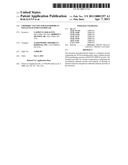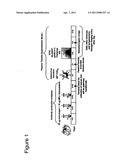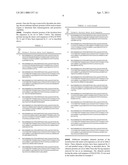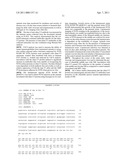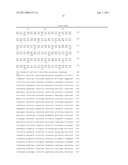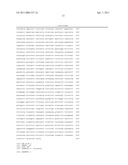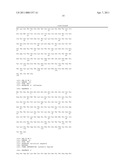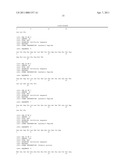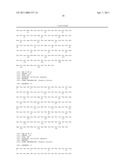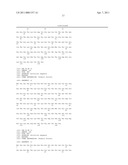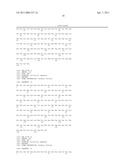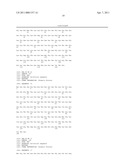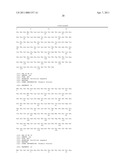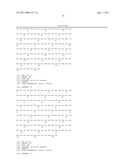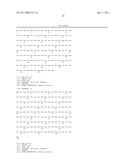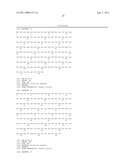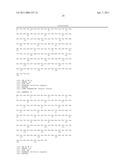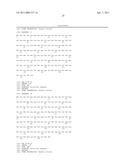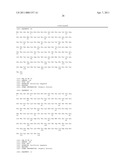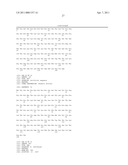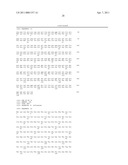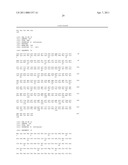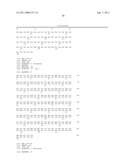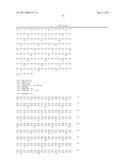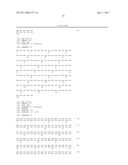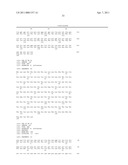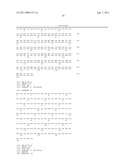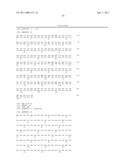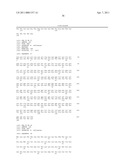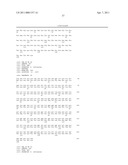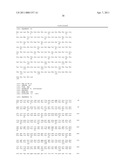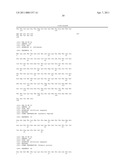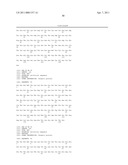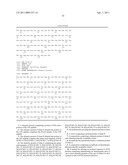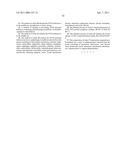Patent application title: Chimeric Vaccine for Haemophilus Influenzae-Induced Disease
Inventors:
Lauren O. Bakaletz (Hilliard, OH, US)
Lauren O. Bakaletz (Hilliard, OH, US)
Robert S. Munson, Jr. (Hilliard, OH, US)
Robert S. Munson, Jr. (Hilliard, OH, US)
Assignees:
NATIONWIDE CHILDREN'S HOSPITAL, INC.
IPC8 Class: AA61K39102FI
USPC Class:
4241641
Class name: Drug, bio-affecting and body treating compositions immunoglobulin, antiserum, antibody, or antibody fragment, except conjugate or complex of the same with nonimmunoglobulin material binds bacterium or component thereof or substance produced by said bacterium
Publication date: 2011-04-07
Patent application number: 20110081357
Claims:
1. A chimeric protein comprising a portion of PilA and a portion of the
LB1 peptide.
2. The chimeric protein of claim 1 wherein the portion of the LB1 peptide comprises the B-cell epitope of the LB1 peptide.
3. The chimeric protein of claim 2 wherein the portion of the LB1 peptide comprises the amino acid sequence of SEQ ID NO: 4, SEQ ID NO: 6, SEQ ID NO: 7 or SEQ ID NO: 8.
4. The chimeric protein of claim 1 comprising the amino acid sequence of SEQ ID NO: 9, SEQ ID NO: 10, SEQ ID NO: 11, SEQ ID NO: 12, SEQ ID NO: 13, SEQ ID NO: 14, SEQ ID NO: 15, SEQ ID NO: 16, SEQ ID NO: 17, SEQ ID NO: 18, SEQ ID NO: 19, SEQ ID NO: 20, SEQ ID NO: 21, SEQ ID NO: 22, SEQ ID NO: 23, SEQ ID NO: 24, SEQ ID NO: 25, SEQ ID NO: 26, SEQ ID NO: 27, SEQ ID NO:28, SEQ ID NO: 29, SEQ ID NO: 30, SEQ ID NO: 31, SEQ ID NO: 32, SEQ ID NO: 54, SEQ ID NO: 55 or SEQ ID NO: 56.
5. A polynucleotide encoding the chimeric protein of claim 1.
6. A vector comprising a polynucleotide of claim 5.
7. A composition comprising a chimeric protein of claim 1 and a pharmaceutically acceptable carrier.
8. An antibody that specifically binds to a chimeric protein of claim 1.
9. A composition comprising an antibody of claim 8 and a pharmaceutically acceptable carrier.
10. A method for eliciting an immune response to NTHi bacteria comprising administering an immunogenic dose of one or more chimeric proteins of any one of claims 1 to 4 to a patient at risk of NTHi bacterial infection.
11. The method of claim 10 wherein the NTHi infection is in the middle ear, nasopharynx or lower airway.
12. A method of treating or preventing NTHi bacterial infection comprising administering an antibody of claim 8 to a patient in need thereof.
13. The method of claim 12 wherein the NTHi infection is in the middle ear.
14. The method of claim 10 wherein the NTHi bacterial infection involves a pathological condition selected from the group consisting of otitis media, pneumonia, sinusitis, septicemia, endocarditis, epiglottitis, septic arthritis, meningitis, sepsis, salpingitis, epiglottis, pericardis, cellulitis, osteomyelitis, endocarditis, cholecystitis, intraabdominal infections, urinary tract infection, mastoiditis, aortic graft infection, conjunctitivitis, Brazilian purpuric fever, occult bacteremia, chronic obstructive pulmonary disease, chronic bronchitis, bronchietasis and cystic fibrosis.
15. The chimeric protein of claim 1, wherein the portion of NTHi PilA protein comprises residues 40-149 of SEQ ID NO: 2.
16. The chimeric protein of claim 15 wherein the B-cell epitope of LB1 is inserted before residue 40 of SEQ ID NO: 2.
17. The composition of claim 7 wherein the composition is formulated for a route of administration selected from the group consisting of parenteral, intravenous, oral, buccal, nasal, pulmonary, rectal, intranasal, transdermal, subcutaneous, intramuscular or vaginal administration.
Description:
[0001] This application claims priority to U.S. Provisional Application
No. 60/697,642 filed Jul. 8, 2005 and U.S. Provisional Application No.
60/801,835 filed May 19, 2006, all of which are incorporated by reference
herein in its entirety.
FIELD OF INVENTION
[0002] The invention described herein relates to a chimeric protein comprising the NTHi twitching pilus major subunit protein (PilA) presenting a portion of the NTHi OMP P5 protein. The invention provides for vaccine compositions comprising the chimeric protein and methods of eliciting an immune response using the chimeric proteins of the invention.
BACKGROUND
[0003] The clinical term for middle ear infections is otitis media (OM). According to Klein, Vaccine, 19 (Suppl. 1): S2-S8, 2000, OM is the most common reason for an ill child to obtain healthcare and for a child in the United States to receive antibiotics or undergo general anesthesia. Statistics indicate that 24.5 million physician office visits were made for OM in 1990, representing a greater than 200% increase over those reported in the 1980s. While rarely associated with mortality, the morbidity associated with OM is significant. Hearing loss is a common problem associated with this disease, often affecting a child's behavior, education and development of language skills (Baldwin, Am. J. Otol., 14: 601-604, 1993; Hunter et al., Ann. Otol. Rhinol. Laryngol. Suppl., 163: 59-61, 1994; Teele et al., J. Infect. Dis., 162: 685-694, 1990). The socioeconomic impact of OM is also great, with direct and indirect costs of diagnosing and managing OM exceeding $5 billion annually in the U.S. alone (Kaplan et al., Pediatr. Infect. Dis. J., 16: S9-11, 1997).
[0004] OM is thought to result from infectious, environmental and host genetics factors. Bacteria such as Haemophilus influenzae, Streptococcus pneumoniae and Moraxella catarrhalis are the most common infectious organisms in OM. Acute OM is a disease characterized by rapid onset and short duration of signs and symptoms of inflammation in the middle ear, while chronic OM refers to a condition that is defined by the relatively asymptomatic presence of fluid (or effusion) in the middle ear. However, in chronic OM, despite the absence of certain signs of acute infection (i.e., ear pain or fever), these abnormal middle ear fluids can persist for periods exceeding three months. Treatment of acute OM by antibiotic therapy is common, but multiple antibiotic-resistant bacteria have emerged in all three Genera of bacteria responsible for OM. Surgical management of chronic OM involves the insertion of tympanostomy tubes through the tympanic membrane of the ear while a child is under general anesthesia. While this procedure is commonplace (prevalence rates are ˜1 million tubes inserted per year in the U.S. Bright et al., Am. J. Public Health, 83(7): 1026-8, 1993) and is highly effective in terms of relieving painful symptoms by draining the middle ear of accumulated fluids, it is invasive and carries incumbent risks (Berman et al., Pediatrics, 93(3):353-63, 1994; Bright et al., supra.; Cimons, ASM News, 60: 527-528; Paap, Ann. Pharmacother., 30(11): 1291-7, 1996). There is thus a need for additional approaches to the management and, preferably, the prevention of OM.
[0005] OM vaccine development is most advanced for S. pneumoniae, the primary causative agent of acute OM (AOM), as evidenced by the recent approval and release of a seven-valent capsular-conjugate vaccine, PREVNAR® (Eskola and Kilpi, Pedriatr. Infect. Dis. J. 16: S72-78, 2000). While PREVNAR® has been highly efficacious for invasive pneumococcal disease, coverage for OM has been disappointing (6-8%) with reports of an increased number of OM cases due to serotypes not included in the vaccine (Black et al., Pedriatr. Infect. Dis J., 19: 187-195, 2000; Eskola et al., Pedriatr. Infect. Dis J., 19: S72-78, 2000; Eskola et al., N. Engl. J. Med., 344: 403-409, 2001; Snow et al., Otol. Neurotol., 23: 1-2, 2002).
[0006] H. influenzae is a gram-negative bacterium that, as noted above, plays a role in OM. Clinical isolates of H. influenzae are classified either as serotypes "a" through "f" or as non-typeable depending on the presence or absence, respectively, of type-specific polysaccharide capsules on the bacteria. A vaccine for H. influenzae type b has been developed. Like PREVNAR®, the type b H. influenzae vaccines target the polysaccharide capsule of this organism and thus the vaccine is comprised of capsule polysaccharide that has been conjugated to a protein carrier. Neither PREVNAR® or the type b H. influenzae vaccine have any efficacy for NTHI-induced respiratory tract diseases, including OM. Less progress has been made for a vaccine for non-typeable H. influenzae (NTHi) which causes approximately 20% of acute OM in children and predominates in chronic OM with effusion (Coleman et al., Inf and Immunity, 59(5), 1716-1722, 1991; Klein, Pedriatr. Infect. Dis J., 16, S5-8, 1997; Spinola et al., J. Infect. Dis., 154, 100-109, 1986). NTHi can also cause pneumonia, sinusitis, septicemia, endocarditis, epiglottitis, septic arthritis, meningitis, postpartum and neonatal infections, postpartum and neonatal sepsis, acute and chronic salpingitis, pericardis, cellulitis, osteomyelitis, endocarditis, cholecystitis, intraabdominal infections, urinary tract infection, mastoiditis, aortic graft infection, conjunctitivitis, Brazilian purpuric fever, occult bacteremia and exacerbation of underlying lung diseases such as chronic bronchitis, bronchietasis and cystic fibrosis. A prototype NTHi isolate is the low passage isolate 86-028NP which was recovered from a child with chronic OM. This strain has been well characterized in vitro (Bakaletz et al., Infect. Immun., 53: 331-5, 1988; Holmes et al., Microb. Pathog., 23: 157-66, 1997) as well as in chinchilla OM models (Bakaletz et al., Vaccine, 15: 955-61, 1997; Suzuki et al., Infect. Immun., 62: 1710-8, 1994; DeMaria et al., Infect. Immun., 64: 5187-92, 1996). The NTHi strain 86-026NP was deposited with the American Type Culture Collection, 10801 University Blvd., Manassas, Va. 20110, on Oct. 16, 2001 and assigned accession no. PTA-4764. A contig set from the genome of stain 86-028NP can be found at Columbus Children's Research Institute Center for Microbial Pathogenesis web site.
[0007] Adherence and colonization are acknowledged first steps in the pathogenesis of H. influenzae-induced diseases. As such, H. influenzae express multiple adhesins including hemagglutinating pili, fimbriae and non-fimbrial adhesins (Gilsdorf et al., Pediatr Res 39, 343-348, 1996; Gilsdorf., Infect. Immun., 65, 2997-3002, 1997; and St. Geme III, Cell. Microbiol., 4, 191-200, 2002). Notably, none of the adhesins described have previously been associated with a motility function. Moreover, H. influenzae do not express flagella which are also associated with motility. Twitching motility is a flagella-independent form of bacterial translocation over moist surfaces and occurs by extension, tethering, and then retraction of polar structures known as type IV pili (Bardy., Microbiology, 149, 295-304, 2003; Tonjum and Koomey, Gene, 192, 155-163, 1997; Wolfgang et al., EMBO J., 19, 6408-6418; Mattick, Annu. Rev. Microbiol., 56, 289-314, 2002). Type N pili are typically 5-7 nm in diameter, several micrometers in length and comprised of a single protein subunit assembled into a helical conformation with ˜5 subunits per turn (Bardy et al., Microbiology, 149, 295-304, 2003; Wall and Kaiser, Mol. Microbiol., 32, 1-10, 1999). Type IV pilin subunits are usually 145-160 ammo acids in length and may be glycosylated or phosphorylated. There are two classes of pilin subunits, type IVa and type IVb, which are distinguished from one another by the average length of the leader peptide and the mature subunit, which N-methylated amino acid occupies the N-terminal position of the mature protein, and the average length of the D-region (for disulfide region). Most of the respiratory pathogens express class IVa pilins, whereas the enteropathogens more typically express class IVb pilins. Type IVa pili are distinguished by the presence of a highly conserved, hydrophobic N-terminal methylated phenylalanine.
[0008] Type N pili serve as a means of rapid translocation over and colonization of new surfaces. Thus type IV pilus expression is important to both adherence and biofilm formation by many bacteria (Mattick, Annu. Rev. Microbial., 56, 289-314 2002; O'Toole and Kolter, Mol. Microbial., 30, 295-304, 1998; Klausen et al., Mol. Microbial., 50, 61-68, 2003; Jesaitis et al., J. Immunol., 171, 4329-4339, 2003), as well as virulence of Neisseria species, Moraxella bovis, Vibrio cholerae, enteropathogenic Escherichia coli and Pseudomonas aeruginosa, among others (O'Toole and Kolter, supra; Klausen et al., supra; Klausen et al., Mol. Microbial., 48, 1511-1524, 2003; Strom and Lory, Annu. Rev. Microbial., 47, 565-596, 1993). A biofilm is a complex organization of bacteria that are anchored to a surface via a bacterially extruded matrix, comprised of exopolysaccharide or other substances. The matrix envelopes the bacteria and protects it from the human immune system. Ehrlich et al., JAMA, 287(13), 1710-1715 (2002) describes biofilm formation by H. influenzae. It has been postulated that blocking the interaction between type IV pili and the human body can avoid or stop the bacterial infection (Meyer et al., U.S. Pat. No. 6,268,171 issued Jul. 31, 2001).
[0009] Type IV pilus expression is a complex and highly regulated bacterial function. In P. aeruginosa, the biogenesis and function of type N pili is controlled by over forty genes (Strom and Lory, supra). To date, only a subset of the vast number of related type IV pilus genes (Tonjum and Koomey, supra; Darzins and Russell, Gene, 192, 109-115, 1997) have been found in several members of the HAP (Haemophilus, Actinobacillus and Pasteurella) family (Stevenson et al., Vet. Microbial., 92, 121-134, 2003; Doughty et al., Vet. Microbial., 72, 79-90, 2000; Dougherty and Smith, Microbiology, 145, 401-409 1999), but neither expression of type Iv pili nor twitching motility has ever been described for any H. influenzae isolate. In fact, H. influenzae is classically described as a bacterium that does not express these structures (Friedrich et al. Appl. Environ. Microbiol., 69, 3695-3700, 2003; Fussenegger et al., Gene, 192, 125-134, 1997), despite the presence of a cryptic gene cluster within the strain Rd genome (Fleischmann et al., Science, 269, 496-512, 1995). Strain Rd is a non-encapsulated derivative of an H. influenzae serotype d organism (Zwahlen et al., Infect. Immun., 42, 708-715, 1983; Bendler and Goodgal, J. Microbiol., 70, 411-422, 1972; Risberg et al., Eur. J. Biochem., 261, 171-180, 1999). Although strain Rd has some virulence properties, serotype d strains are generally considered to be commensals; they do not frequently cause disease (Daines et al., J. Med. Microbiol., 52, 277-282, 2003). It is therefore important to make the distinction between disease-causing strains of H. influenzae and strain Rd.
[0010] Fimbriae, which are surface appendages found on non-typable Haemophilus influenzae, are produced by 100% of the bacteria recovered from the middle ears and nasopharyngeal region of children with chronic otitis media. A vaccine comprised of fimbrin, a filamentous protein derived from the fimbriae of non-typable Haemophilus influenzae was previously developed and is useful in studying, preventing, or reducing the severity of otitis media. However, existing methodologies to isolate fimbrin protein from the bacterial outer membrane are tedious and time-consuming. Similarly, purification of fimbrin expressed by the fimbrin gene in other host vector, is also tedious due to the homology between the fimbrin protein and the outer membrane proteins of the host vector.
[0011] The synthetic chimeric vaccine candidate, denoted as LB1 and described in U.S. Pat. No. 5,843,464, has shown tremendous efficacy in multiple pre-clinical vaccine trials in two rodent hosts. This synthetic peptide comprises a B-cell epitope of P5-fimbrin collinearly synthesized with a T-cell promiscuous epitope derived from a fusion protein of the measles vaccine. Whereas LB1 peptide has been shown to be efficacious in pre-clinical trials, there is concern about the ability to test and market a vaccine that contains a T-cell promiscuous epitope for intended use in very young children. Therefore, there is a need to develop vaccine candidate that elicit a specific and controlled immune response to H. influenzae.
SUMMARY OF THE INVENTION
[0012] The present invention relates to chimeric proteins comprising a portion of the Type IV pilus major subunit protein (PilA) of nontypeable H. influenzae (NTHi) and a portion of NTHi OMP P5 protein (also called P5-fimbrin, fimbrin or OMP P5-homologous adhesin). In particular, the invention provides for chimeric proteins comprising PilA modified to present the B-cell epitope of the LB1 peptide. The invention also provides vaccine compositions comprising one or more chimeric proteins of the invention and methods of eliciting an immune response using the chimeric proteins of the invention.
[0013] The LB1 peptide is a 40 amino acid synthetic chimeric P5-fimbrin derived peptide (SEQ ID NO: 53) that induces an immunogenic response to NTHi and is advantageous because it does not require tedious purification techniques. The LB 1 peptide comprises an N-terminal 19 amino acid peptide that is a B-cell epitope (SEQ ID NO: 4). The B-cell epitope was derived from the predicted surface-exposed loop 3 of an outer membrane protein (fimbrin) of NTHi denoted as OMP P5 (also called P5-fimbrin or OMP P5-homologous adhesin). The LB1 peptide further comprises a short 5-mer linker peptide and a 16-residue T cell promiscuous eptiope. The T cell epitope was derived from a fusion protein of the measles virus. The T cell promiscuous epitope induces a very strong T cell response in individuals exposed to this epitope.
[0014] The present invention contemplates inserting a portion or fragment of the LB 1 peptide into a safer and selective carrier protein that does not reduce the effectiveness of inducing a B-cell response. Preferably, the portion of the LB 1 peptide is inserted into a carrier that itself also confers protection against NTHi-induced diseases. One such carrier that may induce protection against NTHi induced diseases is the protein that comprises the NTHi Type IV pilus (twitching pilus) protein, also known as PilA protein (SEQ ID NO: 2). The PilA protein is encoded by the pilA gene (SEQ ID NO: 1).
[0015] The present invention provides for chimeric proteins comprising a portion of the LB 1 peptide in order to present the peptide to induce an immunogenic response. The invention contemplates presenting a portion of the LB1 peptide that is 12 to 35 amino acids, more preferably presenting a portion of the LB1 peptide that is 15 to 30 amino acids, and most preferably presenting a portion of the LB1 peptide that is 18 to 19 amino acids and is a subunit of the fimbrin protein. A preferred portion of the LB 1 peptide is the N-terminal amino acid sequence RSDYKFYEDANGTRDHKKG (SEQ ID NO: 4).
[0016] In another embodiment, the invention provides for chimeric protein wherein the PilA protein is modified to present a 24 amino acid peptide. The 24 amino acid peptide may comprise the B-cell epitope of the LB1 peptide modified as set out in the amino acid sequence of SEQ ID NO: 5 (LVRSDYKFYEDANGTRDHKKGRHT) in which a leucine and valine are added to the N terminus of the B-cell epitope of LB1 and an arginine, histidine and threonine are at the C terminus of the B-cell epitope of LB 1. These modifications to the B-cell epitope are contemplated to assist in protein folding and/or antigen presentation. The invention further contemplates any modifications to the B-cell epitope of LB1 that will assist in protein folding and/or antigen presentation.
[0017] The amino acid sequence of the surface exposed loop 3 of NTHi OMP P5 can vary between NTHi strains. The invention contemplates chimeric proteins comprising a portion of the PilA protein modified to present the B cell epitope of any variant amino acid sequence of loop 3 of the NTHi OMP P5. In particular, the invention provides for chimeric proteins wherein the PilA protein is modified to present one of the following variant NTHi OMP P5 amino acids sequences: RSDYKLYNKNSSSNSTLKNLGE (SEQ ID NO: 6), RSDYKLYNKNSSTLKDLGE (SEQ ID NO: 7) and RSDYKFYDNKRID (SEQ ID NO: 8). The variant peptides also may be presented with a leucine and valine added to the N terminus and an arginine, histidine and threonine added to the C terminus or any other modification to assist in protein folding and/or antigen presentation.
[0018] The chimeric proteins of the invention comprise the modified PilA amino acids wherein the native PilA amino acids have been substituted with a portion of the LB1 peptide. In addition, the chimeric proteins of the invention comprise a modified PilA amino acid sequence wherein a portion of the LB1 peptide is inserted within and in addition to the native PilA amino acids. The chimeric proteins of the invention have the ability to induce the formation of antibodies directed against two proteins and therefore are more effective and more specific vaccine candidates.
[0019] In one embodiment, the chimeric proteins comprise the mature amino acid sequence (residues 13-149) of the NTHi PilA protein (SEQ ID NO: 2) wherein a portion of the LB 1 peptide is inserted between the cysteine residues at positions 62 and 72 of SEQ ID NO: 2 and may substitute the native amino acids, such as the chimeric protein having the amino acid sequence of SEQ ID NO: 54. This chimeric protein comprises residues 40-149 of SEQ ID NO: 2 and has the B-cell epitope of LB1 (SEQ ID NO: 5) inserted between residues 62 and 72 of SEQ ID NO: 2. In another embodiment, the portion of the LB1 peptide is inserted between the cysteine residues at positions 131 and 144 of SEQ ID NO: 2 and may substitute the native amino acids such as the protein having the amino acid sequence of SEQ ID NO: 55. This chimeric protein comprises residues 40-149 of SEQ ID NO: 2 and has the B-cell epitope of LB1 (SEQ ID NO: 5) inserted between residues 131 and 144 of SEQ ID NO: 2.
[0020] In another embodiment, the chimeric proteins comprise the mature amino acid sequence (residues 13-149) of the NTHi PilA protein (SEQ ID NO: 2) wherein the portion of the LB1 peptide is inserted at the C-terminus of the PilA protein. For example, the chimeric protein of SEQ ID NO: 56 comprises residues 40-149 of SEQ ID NO: 2 and the B-cell epitope of LB1 (SEQ ID NO: 5) is inserted following residue 149 of SEQ ID NO: 2.
[0021] In another embodiment, the chimeric proteins comprise the mature amino acid sequence (residues 13-149) of NTHi PilA protein (SEQ ID NO: 2) wherein the portion of the LB1 peptide is inserted at the N-terminus of the PilA protein. For example, the chimeric protein of SEQ ID NO: 57 comprises residues 40-149 of SEQ ID NO: 2 and the B-cell epitope of LB1 (SEQ ID NO: 5) is inserted before residue 40 of SEQ ID NO: 2.
[0022] In a further embodiment, the invention provides for chimeric proteins comprising a portion of the NTHi PilA protein and one or more of the LB1 peptides described herein. The chimeric proteins of the invention include those which present the same LB1 peptide more than once within a portion of the NTHi PilA protein and those which present two or more different LB 1 peptides within a portion of the NTHi PilA protein.
[0023] The invention further provides for chimeric proteins comprising a portion of the NTHi PilA protein and any antigenic protein that will elicit an immune response.
The NTHi Type IV Pilus (PilA) Polynucleotides and Polypeptides of the Invention
[0024] The chimeric proteins of the invention may comprise the full length or a portion of the major subunit of the NTHi Type IV Pilus which is encoded by the gene pilA. The PilA protein of the NTHi isolate 86-028NP is encoded by the nucleic acid sequence set out as SEQ ID NO: 2, which is described in U.S. patent application Ser. No. 11/019,005, incorporated by reference herein in its entirety. Also provided are polynucleotides encoding PilA polypeptides from NTHi clinical isolates 1728MEE, 1729MEE, 3224A, 10548MEE, 1060MEE, 1885MEE, 1714MEE, 1236MEE, 1128MEE and 214NP. The amino acid sequences of these PilA polypeptides are set out in SEQ ID NOS: 34, 36, 38, 40, 42, 44, 46, 48, 50 and 52 respectively. The possibility of alternative codon usage is specifically contemplated in polynucleotides encoding the polypeptides. In one embodiment, the polypeptides are respectively encoded by the nucleotide sequences set out in SEQ ID NOS: 33, 35, 37, 39, 41, 43, 45, 47, 49 and 51.
[0025] The invention provides for polynucleotides that hybridize under stringent conditions to (a) the complement of the nucleotide sequences set out in SEQ ID NOS: 1, 33, 35, 37, 39, 41, 43, 45, 47, 49 and 51; (b) a polynucleotide which is an allelic variant of any polynucleotides recited above; (c) a polynucleotide which encodes a species homolog of any of the proteins recited above; or (d) a polynucleotide that encodes a polypeptide comprising a specific domain or truncation of the polypeptides of the present invention. PilA polynucleotides from other non-typeable H. influenzae strains and from H. influenzae strains a, b, c, e and f are specifically contemplated. These polynucleotides can be identified and isolated by techniques standard in the art such as hybridization and polymerase chain reaction using part or all of the polynucleotides of SEQ ID NOS: 1, 33, 35, 37, 39, 41, 43, 45, 47, 49 and 51 as probes or primers, respectively.
[0026] The polynucleotides of the invention also include nucleotide sequences that are substantially equivalent to the polynucleotides recited above. Polynucleotides according to the invention can have, e.g., at least 65%, at least 70%, at least 75%, at least 80%, 81%, 82%, 83%, 84%, 85%, 86%, 87%, 88%, or 89%, more typically at least 90%, 91%, 92%, 93%, or 94% and even more typically at least 95%, 96%, 97%, 98% or 99% sequence identity to the NTHi polynucleotides recited above.
[0027] Included within the scope of the nucleic acid sequences of the invention are nucleic acid sequence fragments that hybridize under stringent conditions to the NTHi nucleotide sequences of SEQ ID NOS: 1, 33, 35, 37, 39, 41, 43, 45, 47, 49 and 51, or complements thereof, which fragment is greater than about 5 nucleotides, preferably 7 nucleotides, more preferably greater than 9 nucleotides and most preferably greater than 17 nucleotides. Fragments of, e.g., 15, 17, or 20 nucleotides or more that are selective for (i.e., specifically hybridize to any one of the PilA polynucleotides of the invention) are contemplated. These nucleic acid sequence fragments capable of specifically hybridizing to an NTHi PilA polynucleotide of the invention can be used as probes to detect NTHi PilA polynucleotides of the invention and/or can differentiate NTHi PilA polynucleotides of the invention from other bacterial genes, and are preferably based on unique nucleotide sequences.
[0028] The term "stringent" is used herein to refer to conditions that are commonly understood in the art as stringent. Hybridization stringency is principally determined by temperature, ionic strength, and the concentration of denaturing agents such as formamide. Examples of stringent conditions for hybridization and washing are 0.015 M sodium chloride, 0.0015 M sodium citrate at 65-68° C. or 0.015 M sodium chloride, 0.0015M sodium citrate, and 50% formamide at 42° C. See Sambrook et al., Molecular Cloning: A Laboratory Manual, 2nd Ed., Cold Spring Harbor Laboratory, (Cold Spring Harbor, N.Y. 1989).
[0029] More stringent conditions (such as higher temperature, lower ionic strength, higher formamide, or other denaturing agent) may also be used, however, the rate of hybridization will be affected. In instances wherein hybridization of deoxyoligonucleotides is concerned, additional exemplary stringent hybridization conditions include washing in 6×SSC 0.05% sodium pyrophosphate at 37° C. (for 14-base oligos), 48° C. (for 17-base oligos), 55° C. (for 20-base oligos), and 60° C. (for 23-base oligos).
[0030] Other agents may be included in the hybridization and washing buffers for the purpose of reducing non-specific and/or background hybridization. Examples are 0.1% bovine serum albumin, 0.1% polyvinyl-pyrrolidone, 0.1% sodium pyrophosphate, 0.1% sodium dodecylsulfate, NaDodSO4, (SDS), ficoll, Denhardt's solution, sonicated salmon sperm DNA (or other non-complementary DNA), and dextran sulfate, although other suitable agents can also be used. The concentration and types of these additives can be changed without substantially affecting the stringency of the hybridization conditions. Hybridization experiments are usually carried out at pH 6.8-7.4, however, at typical ionic strength conditions, the rate of hybridization is nearly independent of pH. See Anderson et al., Nucleic Acid Hybridisation: A Practical Approach, Ch. 4, IRL Press Limited (Oxford, England). Hybridization conditions can be adjusted by one skilled in the art in order to accommodate these variables and allow DNAs of different sequence relatedness to form hybrids.
[0031] As noted above, polynucleotides contemplated by the present invention are not limited to the specific PilA polynucleotides of SEQ ID NOS: 1, 33, 35, 37, 39, 41, 43, 45, 47, 49 and 51, but also include, for example, allelic and species variations thereof. Allelic and species variations can be routinely determined by comparing the sequence provided in SEQ ID NOS: 1, 33, 35, 37, 39, 41, 43, 45, 47, 49 and 51, preferably the open reading frames therein, a representative fragment thereof, or a nucleotide sequence at least 90% identical, preferably 95% identical, to the open reading frames within SEQ ID NOS: 1, 33, 35, 37, 39, 41, 43, 45, 47, 49 and 51 with a sequence from another isolate of the same species or another species. Preferred computer program methods to determine identity and similarity between two sequences include, but are not limited to, the GCG program package, including GAP (Devereux et al., Nucl. Acid. Res., 12: 387, 1984; Genetics Computer Group, University of Wisconsin, Madison, Wis.), BLASTP, BLASTN, and FASTA (Altschul et al., J. Mol. Biol., 215: 403-410, 1990). The BLASTX program is publicly available from the National Center for Biotechnology Information (NCBI) and other sources (BLAST Manual, Altschul et al. NCB/NLM/NIH Bethesda, Md. 20894; Altschul et al., supra). The well known Smith-Waterman algorithm may also be used to determine identity.
[0032] Polynucleotides of the invention may be isolated from natural sources or may be synthesized by standard chemical techniques, e.g., the phosphotriester method described in Matteucci et al., J Am Chem Soc., 103: 3185 (1981).
[0033] The invention provides for chimeric proteins comprising a portion of NTHi PilA protein. In one embodiment the polypeptides comprise the NTHi 86-028NP amino acid sequences respectively set out in SEQ ID NO: 2. Polypeptides of the invention also include PilA polypeptides set out in SEQ ID NOS: 34, 36, 38, 40, 42, 44, 46, 48, 50 and 52. In additional embodiments, the PilA polypeptides of the invention are those of other non-typeable H. influenzae strains and from H. influenzae strains a, b, c, e and f.
[0034] Polypeptides of the invention specifically include peptide fragments (i.e., peptides) or fragments of the PilA polypeptide that retain one or more biological or immunogenic properties of a full length polypeptide of the invention. In one embodiment, PilA peptide fragments provided by the invention are designated TfpQ2, TfpQ3, TfpQ4 and OLP3 and respectively comprise amino acids 35 through 68 of SEQ ID NO: 2, amino acids 69 through 102 of SEQ ID NO: 2, amino acids 103 through 137 of SEQ ID NO: 2, and amino acids 21 through 35 of SEQ ID NO: 2. Another PilA peptide fragment provided by the invention comprises amino acids 40 through 149 of SEQ ID NO: 2.
[0035] The invention also provides for chimeric proteins comprising a portion of a PilA polypeptide with one or more conservative amino acid substitutions that do not affect the biological and/or immunogenic activity of the PilA polypeptide. Alternatively, the PilA polypeptides of the invention are contemplated to have conservative amino acids substitutions which may or may not alter biological activity. The term "conservative amino acid substitution" refers to a substitution of a native amino acid residue with a normative residue, including naturally occurring and normaturally occurring amino acids, such that there is little or no effect on the polarity or charge of the amino acid residue at that position. For example, a conservative substitution results from the replacement of a non-polar residue in a polypeptide with any other non-polar residue. Further, any native residue in the polypeptide may also be substituted with alanine, according to the methods of "alanine scanning mutagenesis". Naturally occurring amino acids are characterized based on their side chains as follows: basic: arginine, lysine, histidine; acidic: glutamic acid, aspartic acid; uncharged polar: glutamine, asparagine, serine, threonine, tyrosine; and non-polar: phenylalanine, tryptophan, cysteine, glycine, alanine, valine, proline, methionine, leucine, norleucine, isoleucine General rules for amino acid substitutions are set forth in Table 1 below.
TABLE-US-00001 TABLE 1 Amino Acid Substitutions Original Exemplary Preferred Residues Substitutions Substitutions Ala Val, Leu, Ile Val Arg Lys, Gln, Asn Lys Asn Gln Gln Asp Glu Glu Cys Ser, Ala Ser Gln Asn Asn Glu Asp Asn Gly Pro, Ala Ala His Asn, Gln, Lys, Arg Arg Ile Leu, Val, Met, Ala, Phe, Leu Leu Norleucine, Ile, Val, Met, Leu Lys Arg, 1,4 Diaminobutyric Arg Met Leu, Phe, Ile Leu Phe Leu, Val, Ile, Ala, Tyr Arg Pro Ala Gly Ser Thr, Ala, Cys Thr Thr Ser Ser Trp Tyr, Phe Tyr Tyr Trp, Phe, Thr, Ser Phe Val Ile, Met, Leu, Phe, Ala, Leu
[0036] The invention also provides for chimeric proteins comprising a portion of a variants of the NTHi PilA polypeptides of the present invention (e.g., a polypeptide exhibiting at least about 65%, at least about 70%, at least about 75%, at least about 80%, at least about 85%, 86%, 87%, 88%, 89%, at least about 90%, 91%, 92%, 93%, 94%, typically at least about 95%, 96%, 97%, more typically at least about 98%, or most typically at least about 99% amino acid identity to a polypeptide of SEQ ID NOS: 2, 34, 36, 38, 40, 42, 44, 46, 48, 50 and 52) that retain biological and/or immunogenic activity.
[0037] The invention contemplates that PilA polynucleotides of the invention may be inserted in a vector for amplification or expression. For expression, the polynucleotides are operatively linked to appropriate expression control sequences such as promoter and polyadenylation signal sequences. Further provided are host cells comprising polynucleotides of the invention. Exemplary prokaryotic host cells include bacteria such as E. coli, Bacillus, Streptomyces, Pseudoinonas, Salmonella and Serratia. Methods of producing polypeptides of the invention by growing the host cells and isolating polypeptide from the host cells or growth medium are specifically contemplated. Alternatively, polypeptides of the invention can be prepared by chemical synthesis using standard means. Particularly convenient are solid phase techniques (see, e.g., Erikson et al., The Proteins (1976) v. 2, Academic Press, New York, p. 255). Automated solid phase synthesizers are commercially available. In addition, modifications in the sequence are easily made by substitution, addition or omission of appropriate residues. For example, a cysteine residue may be added at the carboxy terminus to provide a sulfhydryl group for convenient linkage to a carrier protein, or spacer elements, such as an additional glycine residue, may be incorporated into the sequence between the linking amino acid at the C-terminus and the remainder of the peptide.
[0038] The term "isolated" refers to a substance removed from, and essentially free of, the other components of the environment in which it naturally exists. For example, a polypeptide is separated from other cellular proteins or a DNA is separated from other DNA flanking it in a genome in which it naturally occurs.
[0039] Recombinant PilA protein (rPilA) may be generated to serve as a more readily renewable product. To do this, the published protocol of Keizer et al. (J. Biol. Chem., 276: 24186-14193, 2001), who studied a pilin which also had four Cys residues as it will be critical that rPilA similarly be properly folded so as to possess functional qualities of the native pilin subunit, is utilized. Briefly, a truncated pilin is engineered wherein the first 28 residues are removed from the N-terminus to prevent aggregation, and this truncated pilin will be further engineered to be transported to the periplasm by means of the incorporation of an OmpA leader sequence in the construct. Using this strategy Keizer et al. generated a recombinant soluble monomeric P. aeruginosa pilin protein that was able to bind to its receptor (asialo GM1) in in vitro assays and decrease morbidity and mortality in mice when the peptide was delivered 15 minutes prior to heterologous challenge. This soluble, monomeric, truncated form of NTHi PilA will be useful in the studies described herein.
[0040] The invention also provides for synthetic chimeric proteins. The chimeric proteins may be synthesize, purified and sequenced using standard techniques. For example, the chimeric proteins may be assembled semi-manually by stepwise Fmoc-tert-butyl solid-phase synthesis and purified by HPLC. The composition and amino acid sequence of recombinant and synthetic chimeric proteins may be confirmed by amino acid analysis and/or mass spectral analysis.
Antibodies
[0041] The invention provides antibodies which bind to antigenic epitopes of the chimeric proteins of the invention. The antibodies may be polyclonal antibodies, monoclonal antibodies, antibody fragments which retain their ability to bind their unique epitope (e.g., Fv, Fab and F(ab)2 fragments), single chain antibodies and human or humanized antibodies. Antibodies may be generated by techniques standard in the art using chimeric protein(s) of the invention or host cells expressing chimeric protein(s) of the invention as antigens.
[0042] The present invention provides for antibodies specific for the chimeric proteins of the present invention and fragments thereof, which exhibit the ability to kill both H. influenzae bacteria and to protect humans from infection. The present invention also provides for antibodies specific for the chimeric proteins of the invention which reduce the virulence, inhibit adherence, inhibit biofilm formation, inhibit twitching motility, inhibit cell division, and/or inhibit penetration into the epithelium of H. influenzae bacteria and/or enhance phagocytosis of the H. influenzae bacteria.
[0043] In vitro complement mediated bactericidal assay systems (Musher et al., Infect. Immun. 39: 297-304, 1983; Anderson et al., J. Clin. Invest. 51: 31-38, 1972) may be used to measure the bactericidal activity of anti-chimeric proteins antibodies.
[0044] It is also possible to confer short-term protection to a host by passive immunotherapy via the administration of pre-formed antibody against a chimeric protein of the invention. Thus, antibodies of the invention may be used in passive immunotherapy. Human immunoglobulin is preferred in human medicine because a heterologous immunoglobulin may provoke an immune response to its foreign immunogenic components. Such passive immunization could be used on an emergency basis for immediate protection of unimmunized individuals subject to special risks.
[0045] In another embodiment, antibodies of the invention may be used in the production of anti-idiotypic antibody, which in turn can be used as an antigen to stimulate an immune response against the chimeric protein epitopes or H. influenzae epitopes.
Methods for Eliciting an Immune Response and Compositions Therefor
[0046] The invention contemplates methods of eliciting in an individual an immune response to H. influenzae in an individual. In certain embodiments, the methods elicit an immune response to the chimeric proteins of the invention. These methods elicit one or more immune responses, including but not limited to, immune responses which inhibit bacterial replication, immune responses which block H. influenzae adherence to cells, immune responses which prevent H. influenzae in twitching, immune responses that kill H. influenzae bacteria and immune responses which prevent biofilm formation. In one embodiment, the methods comprise a step of administering an immunogenic dose of a composition comprising one or more chimeric proteins of the invention. In another embodiment, the methods comprise administering an immunogenic dose of a composition comprising a cell expressing one or more chimeric proteins of the invention. In yet another embodiment, the methods comprise administering an immunogenic dose of a composition comprising one or more polynucleotides encoding one or more chimeric proteins of the invention. The polynucleotide may be a naked polynucleotide not associated with any other nucleic acid or may be in a vector such as a plasmid or viral vector (e.g., adeno-associated virus vector or adenovirus vector). The methods may be used in combination in a single individual. The methods may be used prior or subsequent to H. influenzae infection of an individual. The methods and compositions of the invention may be used to treat or prevent any pathological condition involving H. influenzae (typeable and nontypeable strains) such as OM, pneumonia, sinusitis, septicemia, endocarditis, epiglottitis, septic arthritis, meningitis, postpartum and neonatal infections, postpartum and neonatal sepsis, acute and chromic salpingitis, epiglottis, pericardis, cellulitis, osteomyelitis, endocarditis, cholecystitis, intraabdominal infections, urinary tract infection, mastoiditis, aortic graft infection, conjunctitivitis, Brazilian purpuric fever, occult bacteremia, chronic obstructive pulmonary disease and exacerbation of underlying lung diseases such as chronic bronchitis, bronchietasis and cystic fibrosis.
[0047] In one embodiment of methods of the invention, a composition of the invention is administered as a priming dose followed by one or more booster doses. Co-administration of proteins or polypeptides that beneficially enhance the immune response such as cytokines (e.g., IL-2, IL-12, GM-CSF), cytokine-inducing molecules (e.g. Leaf) or co-stimulatory molecules is also contemplated.
[0048] An "immunogenic dose" of a composition of the invention is one that generates, after administration, a detectable humoral (antibody) and/or cellular (T cell) immune response in comparison to the immune response detectable before administration or in comparison to a standard immune response before administration. The invention contemplates that the immune response resulting from the methods may be protective and/or therapeutic. In a preferred embodiment, the antibody and/or T cell immune response protects the individual from H. influenzae infection, particularly infection of the middle ear and/or the nasopharynx or lower airway. In this use, the precise dose depends on the patient's state of health and weight, the mode of administration, the nature of the formulation, etc., but generally ranges from about 1.0 μg to about 5000 μg per 70 kilogram patient, more commonly from about 10 to about 500 μg per 70 kg of body weight.
[0049] Humoral immune response may be measured by many well known methods, such as Single Radial Immunodiffussion Assay (SRID), Enzyme Immunoassay (ETA) and Hemagglutination Inhibition Assay (HAI). In particular, SRID utilizes a layer of a gel, such as agarose, containing the immunogen being tested. A well is cut in the gel and the serum being tested is placed in the well. Diffusion of the antibody out into the gel leads to the formation of a precipitation ring whose area is proportional to the concentration of the antibody in the serum being tested. EIA, also known as ELISA (Enzyme Linked Immunoassay), is used to determine total antibodies in the sample. The immunogen is adsorbed to the surface of a microtiter plate. The test serum is exposed to the plate followed by an enzyme linked immunoglobulin, such as IgG. The enzyme activity adherent to the plate is quantified by any convenient means such as spectrophotometry and is proportional to the concentration of antibody directed against the immunogen present in the test sample. HAI utilizes the capability of an immunogen such as viral proteins to agglutinate chicken red blood cells (or the like). The assay detects neutralizing antibodies, i.e., those antibodies able to inhibit hemagglutination. Dilutions of the test serum are incubated with a standard concentration of immunogen, followed by the addition of the red blood cells. The presence of neutralizing antibodies will inhibit the agglutination of the red blood cells by the immunogen. Tests to measure cellular immune response include determination of delayed-type hypersensitivity or measuring the proliferative response of lymphocytes to target immunogen.
[0050] The invention correspondingly provides compositions suitable for eliciting an immune response to chimeric proteins of the invention. As noted above, the compositions comprise one or more chimeric proteins, cells expressing one or more chimeric proteins, or one or more polynucleotides encoding one or more chimeric proteins. The compositions may also comprise other ingredients such as carriers and adjuvants.
[0051] In compositions of the invention, a chimeric protein may be fused to another protein when produced by recombinant methods. In one embodiment, the other protein may not, by itself, elicit antibodies, but it stabilizes the first protein and fauns a fusion protein retaining immunogenic activity. In another embodiment, the fusion protein comprises another protein that is immunogenic, such as Glutathione-S-transferase (GST) or beta-galactosidase, relatively large co-proteins which solubilize the fusion protein and facilitate production and purification thereof. The other protein may act as an adjuvant in the sense of providing a generalized stimulation of the immune system. The other protein may be fused to either the amino or carboxy terminus of the chimeric proteins of the invention.
[0052] In other compositions of the invention, chimeric proteins may be otherwise linked to carrier substances. Any method of creating such linkages known in the art may be used. Linkages can be formed with hetero-bifunctional agents that generate a disulfide link at one functional group end and a peptide link at the other, such as a disulfide amide forming agent, e.g., N-succidimidyl-3-(2-pyridyldithio) proprionate (SPDP) (See, e.g., Jansen et al., Immun. Rev. 62:185, 1982) and bifunctional coupling agents that form a thioether rather than a disulfide linkage such as reactive esters of 6-maleimidocaproic acid, 2-bromoacetic acid, 2-iodoacetic acid, 4-(N-maleimido-methyl)cyclohexane-1-carboxylic acid and the like, and coupling agent which activate carboxyl groups by combining them with succinimide or 1-hydroxy-2-nitro-4-sulfonic acid, for sodium salt such as succinimmidyl 4-(N-maleimido-methyl) cyclohexane-1-carobxylate (SMCC).
[0053] The chimeric proteins may be formulated as neutral or salt forms. Pharmaceutically acceptable salts, include the acid addition salts (formed with the free amino groups of the peptide) and which are formed with inorganic acids such as, e.g., hydrochloric or phosphoric acids, or such organic acids as acetic, oxalic, tartaric, mandelic. Salts formed with the free carboxyl groups may also be derived from inorganic bases such as, e.g., sodium, potassium, ammonium, calcium, or ferric hydroxides, and such organic bases as isopropylamine, trimethylamine, 2-ethylamino ethanol, histidine, and procaine.
[0054] Compositions of the invention may further comprise adjuvants. Known adjuvants include, for example, emulsions such as Freund's Adjuvants and other oil emulsions, Bordetella pertussis, MF59, purified saponin from Quillaja saponaria (QS21), aluminum salts such as hydroxide, phosphate and alum, calcium phosphate, (and other metal salts), gels such as aluminum hydroxide salts, mycobacterial products including muramyl dipeptides, solid materials, particles such as liposomes and virosomes. Examples of natural and bacterial products known to be used as adjuvants include monophosphoryl lipid A (MPL), RC-529 (synthetic MPL-like acylated monosaccharide), OM-174 which is a lipid A derivative from E. coli, holotoxins such as cholera toxin (CT) or one of its derivatives, pertussis toxin (PT) and heat-labile toxin (LT) of E. coli or one of its derivatives, and CpG oligonucleotides. Adjuvant activity can be affected by a number of factors, such as carrier effect, depot formation, altered lymphocyte recirculation, stimulation of T-lymphocytes, direct stimulation of B-lymphocytes and stimulation of macrophages.
[0055] Compositions of the invention are typically formulated as injectables, either as liquid solutions or suspensions; solid forms suitable for solution in, or suspension in, liquid prior to injection may also be prepared. The preparation may also be emulsified. The active immunogenic ingredient is often mixed with excipients, which are pharmaceutically acceptable and compatible with the active ingredient. Suitable excipients are, e.g., water, saline, dextrose, glycerol, ethanol, or the like and combinations thereof. In addition, if desired, the vaccine may contain minor amounts of auxiliary substances such as wetting or emulsifying agents, pH buffering agents, or adjuvants, which enhance the effectiveness of the vaccine. The vaccines are conventionally administered parenterally, by injection, for example, either subcutaneously or intramuscularly.
[0056] Additional formulations which are suitable for other modes of administration include suppositories and, in some cases, oral formulations. For suppositories, traditional binders and carriers may include, for example, polyalkalene glycols or triglycerides; such suppositories may be formed from mixtures containing the active ingredient in the range of 0.5% to 10%, preferably 1-2%. Oral formulations include such normally employed excipients as, for example, pharmaceutical grades of mannitol, lactose, starch, magnesium stearate, sodium saccharine, cellulose, magnesium carbonate and the like. These compositions take the form of solutions, suspensions, tablets, pills, capsules, sustained release formulations or powders and contain 10%-95% of active ingredient, preferably 25-70%.
[0057] Compositions may also be administered through transdermal routes utilizing jet injectors, microneedles, electroporation, sonoporation, microencapsulation, polymers or liposomes, transmucosal routes and intranasal routes using nebulizers, aerosols and nasal sprays. Microencapsulation using natural or synthetic polymers such as starch, alginate and chitosan, D-poly L-lactate (PLA), D-poly DL-lactic-coglycolic microspheres, polycaprolactones, polyorthoesters, polyanhydrides and polyphosphazenes polyphosphatazanes are useful for both transdermal and transmucosal administration. Polymeric complexes comprising synthetic poly-ornithate, poly-lysine and poly-arginine or amphipathic peptides are useful for transdermal delivery systems. In addition, due to their amphipathic nature, liposomes are contemplated for transdermal, transmucosal and intranasal vaccine delivery systems. Common lipids used for vaccine delivery include N-(1)2,3-(dioleyl-dihydroxypropyl)-N,N,N,-trimethylammonium-methyl sulfate (DOTAP), dioleyloxy-propyl-trimethylammonium chloride DOTMA, dimystyloxypropyl-3-dimethyl-hydroxyethyl ammonium (DMRIE), dimethyldioctadecyl ammonium bromide (DDAB) and 9N(N',N-dimethylaminoethane) carbamoyl) cholesterol (DC-Chol). The combination of helper lipids and liposomes will enhance up-take of the liposomes through the skin. These helper lipids include dioleoyl phosphatidylethanolamine (DOPE), dilauroylphosphatidylethanolamine (DLPE), dimyristoyl phosphatidylethanolamine (DMPE), dipalmitoylphosphatidylethanolamine (DPPE). In addition, triterpenoid glycosides or saponins derived from the Chilean soap tree bark (Quillaja saponaria) and chitosan (deacetylated chitan) have been contemplated as useful adjuvants for intranasal and transmucosal vaccine delivery.
[0058] Formulations may be presented in unit-dose or multi-dose containers, for example, sealed ampules and vials and may be stored in a freeze-dried condition requiring only the addition of the sterile liquid carrier immediately prior to use.
Methods of Inhibiting H. influenzae
[0059] Alternatively, the invention includes methods of inhibiting H. influenzae type IV pili function in an individual. The methods comprise administering to the individual, for example, one or more antibodies of the invention and/or one or more chimeric proteins of the invention; in an amount that inhibits function of the pili. In vitro assays may be used to demonstrate the ability to inhibit pili function. Embodiments of these methods include, for example, methods using inhibitors of adherence mediated via type IV pili, inhibitors that disrupt existing biofilms mediated by type IV pili, and inhibitors of twitching.
[0060] Inhibition is contemplated for any pathological condition involving H. influenzae, for example, OM, pneumonia, sinusitis, septicemia, endocarditis, epiglottitis, septic arthritis, meningitis, postpartum and neonatal infections, postpartum and neonatal sepsis, acute and chromic salpingitis, epiglottis, pericardis, cellulitis, osteomyelitis, endocarditis, cholecystitis, intraabdominal infections, urinary tract infection, mastoiditis, aortic graft infection, conjunctitivitis, Brazilian purpuric fever, occult bacteremia, chronic obstructive pulmonary disease and exacerbation of underlying lung diseases such as chronic bronchitis, bronchietasis and cystic fibrosis.
[0061] Compositions comprising inhibitors of H. influenzae type IV pili function are provided. The compositions may consist of one of the foregoing active ingredients alone, may comprise combinations of the foregoing active ingredients or may comprise additional active ingredients used to treat bacterial infections. As discussed above, the compositions may comprise one or more additional ingredients such as pharmaceutically effective carriers. Also as discussed above, dosage and frequency of the administration of the compositions are determined by standard techniques and depend, for example, on the weight and age of the individual, the route of administration, and the severity of symptoms. Administration of the pharmaceutical compositions may be by routes standard in the art, for example, parenteral, intravenous, oral, buccal, nasal, pulmonary, rectal, intranasal, or vaginal.
Animal Model
[0062] Methods of the invention may be demonstrated in a chinchilla model widely accepted as an experimental model for OM. In particular, a chinchilla model of NTHi-induced OM has been well characterized (Bakaletz et al., J. Infect. Dis., 168: 865-872, 1993; Bakaletz and Holmes, Clin. Diagn. Lab. Immunol., 4: 223-225, 1997; Suzuki and Bakaletz, Infect. Immun., 62: 1710-1718, 1994; Mason et al., Infect. Immun., 71:3454-3462, 2003), and has been used to determine the protective efficacy of several NTHi outer membrane proteins, combinations of outer membrane proteins, chimeric synthetic peptide vaccine components, and adjuvant formulations against OM (Bakaletz et al., Vaccine, 15: 955-961, 1997; Bakaletz et al., Infect. Immun., 67: 2746-2762, 1999; Kennedy et al., Infect. Immun., 68: 2756-2765, 2000; Kyd et al., Infect. Immun., 66:2272-2278, 2003; Novotny and Bakaletz, J. Immunol., 171, 1978-1983, 2003).
[0063] In the model, adenovirus predisposes chinchillas to H. influenzae-induced OM media, which allowed for the establishment of relevant cell, tissue and organ culture systems for the biological assessment of NTHi (Bakaletz et al., J. Infect. Dis., 168: 865-72, 1993; Suzuki et al., Infect. Immunity 62: 1710-8, 1994). Adenovirus infection alone has been used to assess the transudation of induced serum antibodies into the tympanum (Bakaletz et al., Clin. Diagnostic Lab Immunol., 4(2): 223-5, 1997) and has been used as a co-pathogen with NTHi, to determine the protective efficacy of several active and passive immunization regimens targeting various NTHi outer membrane proteins, combinations of OMPs, chimeric synthetic peptide vaccine components, and adjuvant formulations as vaccinogens against otitis media (Bakaletz et al., Infect Immunity, 67(6): 2746-62, 1999; Kennedy et al., Infect. Immun., 68(5): 2756-65, 2000; Novotny et al., Infect Immunity 68(4): 2119-28, 2000; Poolman et al., Vaccine 19 (Suppl. 1): S108-15, 2000).
BRIEF DESCRIPTION OF DRAWING
[0064] FIG. 1 provides the timeline of the immunization regimen, viral inoculation, bacterial challenge, and OM disease assessment period for the efficacy experiments described in Example 5.
DETAILED DESCRIPTION OF THE INVENTION
[0065] The following examples illustrate the invention wherein Example 1 describes recombinant production of chimeric proteins of the invention, Example 2 describes assays to test the immunogenicity of the chimeric proteins of the invention, Example 3 describes assays for evaluating passive immunization, Example 4 describes assays for evaluating active immunization and Example 5 describes the evaluation of a chimeric protein of the invention.
Example 1
Synthesis of Chimeric Proteins
[0066] The chimeric proteins of the invention were produced using standard recombinant methods. Initially, a gene-synthesis company, (Blue Heron Biotechnology Inc.) was contracted to make the initial plasmid based on the chimeric protein amino acid sequences described herein that were optimized for E. coli preferred codon usage. Briefly, the native NTHi pilin protein sequence was modified by truncating the N-terminus (residues 1-39 of SEQ ID NO: 2) and adding a HIS-tag sequence and a thrombin cleavage site as set out in SEQ ID NO: 3. The HIS-tag was preceded by a sequence (MGSS) to assist in expression. The thrombin cleavage site allowed for release of the HIS-tag. These plasmids were then cloned into the E. coli expression vector pET-15b vector (Novagen). The plasmid were then transformed into E. coli strain "Origami(DE3)" (available from Novagen) as the host for expression of soluble His-tagged chimeric proteins. Another E. coli host cell expression stain that may be used is Origami B(DE3) (Novagen).
[0067] The His-tagged variants of the chimeric proteins will be recovered by nickel column chromatography, then used for initial studies to determine if they are reactive with antisera directed against any of the following: native OMP P5-fimbrin, LB1 (full length 40 amino acid peptide), LB1(1) (a synthetic peptide representing just the 19 amino acid B-cell epitope of LB1), recombinant PilA protein or native PilA protein. Once the His-tag is removed by thrombin site cleavage, the recombinant chimeric proteins will be used as immunogens to determine their immunogenicity and protective capability.
[0068] Exemplary chimeric proteins of the invention have the sequences as set out in Table 2 below. The chimeric proteins having the amino acid sequences of SEQ ID NOS: 10, 12 and 14 have been expressed by E. coli as described above.
TABLE-US-00002 TABLE 2 SEQ ID NO: Chimeric Protein Amino Acid Sequence 9 MGSSHHHHHSSGLVPRGSHMTKKAAVSELLQASAPYKADVEL CRSDYKFYEDANGTRDHKKGCTGGKNGIAADITTAKGYVKSV TTSNGAITVKGDGTLANMEYILQATGNAATGVTWTTCKGTDA SLFPANFCGSVTQ 10 MGSSHHHHHSSGLVPRGSHMTKKAAVSELLQASAPYKADVEL CLVRSDYKFYEDANGTRDHKKGHTCTGGKNGIAADITTAKGY VKSVTTSNGAITVKGDGTLANMEYILQATGNAATGVTWTTCK GTDASLFPANFCGSVTQ 11 MGSSHHHHHSSGLVPRGSHMTKKAAVSELLQASAPYKADVEL CVTSTNETTNCTGGKNGIAADITTAKGYVKSVTTSNGAITVKG DGTLANMEYILQATGNAATGVTWTTCRSDYKFYEDANGTRD HKKGCGSVTQ 12 MGSSHHHHHSSGLVPRGSHMTKKAAVSELLQASAPYKADVEL CVTSTNETTNCTGGKNGIAADITTAKGYVKSVTTSNGAITVKG DGTLANMEYILQATGNAATGVTWTTCLVRSDYKFYEDANGTR DHKKGRHTCGSVTQ 13 MGSSHHHHHSSGLVPRGSHMTKKAAVSELLQASAPYKADVEL CVTSTNETTNCTGGKNGIAADITTAKGYVKSVTTSNGAITVKG DGTLANMEYILQATGNAATGVTWTTCKGTDASLFPANFCGSV TQ RSDYKFYEDANGTRDHKKG 14 MGSSHHHHHSSGLVPRGSHMTKKAAVSELLQASAPYKADVEL CVTSTNETTNCTGGKNGIAADITTAKGYVKSVTTSNGAITVKG DGTLANMEYILQATGNAATGVTWTTCKGTDASLFPANFCGSV TQLVRSDYKFYEDANGTRDHKKGRHT 15 MGSSHHHHHSSGLVPRGSHMTKKAAVSELLQASAPYKADVEL CRSDYKLYNKNSSSNSTLKNLGECTGGKNGIAADITTAKGYVK SVTTSNGAITVKGDGTLANMEYILQATGNAATGVTWTTCKGT DASLFPANFCGSVTQ 16 MGSSHHHHHSSGLVPRGSHMTKKAAVSELLQASAPYKADVEL CLVRSDYKLYNKNSSSNSTLKNLGERHTCTGGKNGIAADITTA KGYVKSVTTSNGAITVKGDGTLANMEYILQATGNAATGVTWT TCKGTDASLFPANFCGSVTQ 17 MGSSHHHHHSSGLVPRGSHMTKKAAVSELLQASAPYKADVEL CVTSTNETTNCTGGKNGIAADITTAKGYVKSVTTSNGAITVKG DGTLANMEYILQATGNAATGVTWTTCRSDYKLYNKNSSSNST LKNLGECGSVTQ 18 MGSSHHHHHSSGLVPRGSHMTKKAAVSELLQASAPYKADVEL CVTSTNETTNCTGGKNGIAADITTAKGYVKSVTTSNGAITVKG DGTLANMEYILQATGNAATGVTWTTCLVRSDYKLYNKNSSSN STLKNLGERHTCGSVTQ 19 MGSSHHHHHSSGLVPRGSHMTKKAAVSELLQASAPYKADVEL CVTSTNETTNCTGGKNGIAADITTAKGYVKSVTTSNGAITVKG DGTLANMEYILQATGNAATGVTWTTCKGTDASLFPANFCGSV TQRSDYKLYNKNSSSNSTLKNLGE 20 MGSSHHHHHSSGLVPRGSHMTKKAAVSELLQASAPYKADVEL CVTSTNETTNCTGGKNGIAADITTAKGYVKSVTTSNGAITVKG DGTLANMEYILQATGNAATGVTWTTCKGTDASLFPANFCGSV TQLVRSDYKLYNKNSSSNSTLKNLGERHT 21 MGSSHHHHHSSGLVPRGSHMTKKAAVSELLQASAPYKADVEL CRSDYKLYNKNSSSLKNLGECTGGKNGIAADITTAKGYVKSVT TSNGAITVKGDGTLANMEYILQATGNAATGVTWTTCKGTDAS LFPANFCGSVTQ 22 MGSSHHHHHSSGLVPRGSHMTKKAAVSELLQASAPYKADVEL CLVRSDYKLYNKNSSSTLKNLGERHTCTGGKNGIAADITTAKG YVKSVTTSNGAITVKGDGTLANMEYILQATGNAATGVTWTTC KGTDASLFPANFCGSVTQ 23 MGSSHHHHHSSGLVPRGSHMTKKAAVSELLQASAPYKADVEL CVTSTNETTNCTGGKNGIAADITTAKGYVKSVTTSNGAITVKG DGTLANMEYILQATGNAATGVTWTTCRSDYKLYNKNSSTLKN LGECGSVTQ 24 MGSSHHHHHSSGLVPRGSHMTKKAAVSELLQASAPYKADVEL CVTSTNETTNCTGGKNGIAADITTAKGYVKSVTTSNGAITVKG DGTLANMEYILQATGNAATGVTWTTCLVRSDYKLSSTL KNLGERHTCGSVTQ 25 MGSSHHHHHSSGLVPRGSHMTKKAAVSELLQASAPYKADVEL CVTSTNETTNCTGGKNGIAADITTAKGYVKSVTTSNGAITVKG DGTLANMEYILQATGNAATGVTWTTCKGTDASLFPANFCGSV TQRSDYKLYNKNSSTLKNLGE 26 MGSSHHHHHSSGLVPRGSHMTKKAAVSELLQASAPYKADVEL CVTSTNETTNCTGGKNGIAADITTAKGYVKSVTTSNGAITVKG DGTLANMEYILQATGNAATGVTWTTCKGTDASLFPANFCGSV TQLVRSDYKLYNKNSSTLKNLGERHT 27 MGSSHHHHHSSGLVPRGSHMTKKAAVSELLQASAPYKADVEL CRSDYKFYDNKRIDCTGGKNGIAADITTAKGYVKSVTTSNGAI TVKGDGTLANMEYILQATGNAATGVTWTTCKGTDASLFPANF CGSVTQ 28 MGSSHHHHHSSGLVPRGSHMTKKAAVSELLQASAPYKADVEL CLVRSDYKFYDNKRIDRHTCTGGKNGIAADITTAKGYVKSVTT SNGAITVKGDGTLANMEYILQATGNAATGVTWTTCKGTDASL FPANFCGSVTQ 29 MGSSHHHHHSSGLVPRGSHMTKKAAVSELLQASAPYKADVEL CVTSTNETTNCTGGKNGIAADITTAKGYVKSVTTSNGAITVKG DGTLANMEYILQATGNAATGVTWTTCRSDYKFYDNKRIDCGS VTQ 30 MGSSHHHHHSSGLVPRGSHMTKKAAVSELLQASAPYKADVEL CVTSTNETTNCTGGKNGIAADITTAKGYVKSVTTSNGAITVKG DGTLANMEYILQATGNAATGVTWTTCLVRSDYKFYDNKRIDR HTCGSVTQ 31 MGSSHHHHHSSGLVPRGSHMTKKAAVSELLQASAPYKADVEL CVTSTNETTNCTGGKNGIAADITTAKGYVKSVTTSNGAITVKG DGTLANMEYILQATGNAATGVTWTTCKGTDASLFPANFCGSV TQRSDYKFYDNKRID 32 MGSSHHHHHSSGLVPRGSHMTKKAAVSELLQASAPYKADVEL CVTSTNETTNCTGGKNGIAADITTAKGYVKSVTTSNGAITVKG DGTLANMEYILQATGNAATGVTWTTCKGTDASLFPANFCGSV TQLVRSDYKFYDNKRIDRHT
[0069] Additional exemplary chimeric proteins of the invention have the amino acid sequences as set out in Table 3 below. These chimeric proteins have been expressed by E. coli and purified using a HIS-tag, as described above. The chimeric proteins set out in Table 3 have the His tag sequence removed for use as an immunogen. The chimeric protein having the amino acid sequence of SEQ ID NO: 56 was used in the studies described in Example 5.
TABLE-US-00003 TABLE 3 SEQ ID NO: Chimeric Protein Amino Acid Sequence 54 GSHMTKKAAVSELLQASAPYKADVELCLVRSDYKFYEDANGT RDHKKGRHTCTGGKNGIAADITTAKGYVKSVTTSNGAITVKG DGTLANMEYILQATGNAATGVTWTTTCKGTDASLFPANFCGS VTQ 55 GSHMTKKAAVSELLQASAPYKADVELCVYSTNETTNCTGGKN GIAADITTAKGYVKSVTTSNGAITVKGDGTLANMEYILQATGN AATGVTWTTTCLVRSDYKFYEDANGTRDHKKGRHTCGSVTQ 56 GSHMTKKAAVSELLQASAPYKADVELCVYSTNETTNCTGGKN GIAADITTAKGYVKSVTTSNGAITVKGDGTLANMEYILQATGN AATGVTWTTTCKGTDASLFPANFCGSVTQLVRSDYKFYEDAN GTRDHKKGRHT 57 GSHMLVRSDYKFYEDANGTRDHKKGRHTGPSLKLTKKAAVSE LLQASAPYKADVELCVYSTNETTNCTGGKNGIAADITTAKGYV KSVTTSNGAITVKGDGTLANMEYILQATGNAATGVTWTTTCK GTDASLFPANFCGSVTQ
Example 2
Immunogenicity of Chimeric Proteins
[0070] Rabbits or chinchillas are immunized with the chimeric proteins. Rabbits receive an initial immunizing dose of 500 μg of a chimeric protein in complete Freund's adjuvant. The rabbits receive a second dose of 400 μg of the chimeric protein 21 days later. The rabbits receive a third dose of chimeric protein in complete Freund's adjuvant 42 days after the initial immunizing dose with 400 μg of the same peptide in either IFA or PBS (one rabbit per diluent). Sera are obtained 3 weeks after each dose. Chinchillas receive an initial immunizing dose of 10 μg of the chimeric protein in the adjuvant monophosphoryl lipid A (MPL). One month (˜30 days) later, chinchillas receive a second identical dose. The third and final dose is delivered ˜30 days after the second dose. Sera are obtained ˜10-14 days after each dose. The sera from all animals are assessed for titer and specificity against the LB 1 peptide (40-mer), LB 1(1), PilA protein and the chimeric proteins, by ELISA, Western blot and biosensor. Antisera are also tested against whole bacteria via flow cytometry (FACS) analysis.
Example 3
Evaluating Passive Immunization
[0071] The protection conferred by an animal's immune response directed against the chimeric proteins of the invention is determined in a chinchilla model of experimental otitis media. Chinchillas are passively immunized with 5 ml/kg hyperimmune chinchilla or human serum directed against a chimeric protein of the invention. Control chinchillas receive normal chinchilla serum or normal human serum. Next the chinchillas receive first a viral co-pathogen intranasally, then a week later, an intranasal challenge with the NTHi bacteria. The chinchillas are examined and rated daily or every 2 days for up to 35 days after bacterial challenge. Immunized chinchillas receiving immune chinchilla or human serum display reduced tympanic membrane pathology and reduced or absent signs of infection of the middle ear space as determined by both video otoscopy and tympanometry. In this assay, the presence of middle ear fluids in chinchillas receiving chinchilla or human anti-chimeric protein serum is reduced when compared to controls.
Example 4
Evaluating Active Immunization
[0072] Cohorts of 5-10 chinchillas each are actively immunized with either a saline control preparation, an adjuvant-only preparation, or one of the chimeric proteins of the invention that has been admixed with an appropriate adjuvant. The immunogens are assessed for endotoxin content prior to their use as an immunogen via a chromogenic Amoebocyte Lysate assay which is commercially available from Whittaker Bioproducts under the designation QCL-1000. The chinchillas are then subcutaneously injected with 10 μg immunogen in the adjuvant MPL (or another appropriate adjuvant). Then 30 days later they receive 10 μg of the same immunogen in MPL. Thirty days following the second immunization, these animals receive the final immunizing dose. Approximately 10-14 days after the final immunizing dose is delivered, chinchillas are challenged both transbullarly and intranasally with a strain of NTHi. The chinchillas are assessed over a 35-day period for: tympanic membrane pathology by video otoscopic examination and tympanometry; semiquantitation of NTHi recovered via epitympanic tap of the inferior bulla and passive lavage of the nasopharynx; and light microscopic examination of fixed middle ear mucosal epithelium and tympanic membrane for histopathology. For example, chinchillas immunized with the chimeric proteins of the invention will have reduced tympanic membrane pathology, will be free of middle ears effusions or they will contain effusions that are culture-negative, there will be reduced or no biofilm present in the tympanum and there will be minimal thickening of the middle ear mucosa, minimal osteoneogensis and reduced presence of both red blood cells and inflammatory cells in the subepithelial space.
Example 5
Evaluation of Chimeric Proteins
[0073] The protective efficacy of the chimeric protein having the amino acid sequence of SEQ ID NO: 56 (referred to as "chim-V3" herein) was evaluated using the chinchilla passive-transfer, superinfection model of OM. This chimeric peptide comprised the B-cell epitope of the LB1 peptide (SEQ ID NO: 5) expressed after the C-terminal glutamine residue of recombinant PilA (residues 40-149 of SEQ ID NO: 2). To generate polyclonal antiserum for use in passive transfer efficacy studies, the chim-V3 protein was delivered to a cohort of adult chinchillas with the adjuvant, monophosphoryl lipid A (MPL) plus trehalose dimycolate (Corixa). A timeline depicting the immunization regimen is set out in FIG. 1. To generate immune serum pools, alert prone chinchillas were immunized subcutaneously 3 times with 30 μg of chim-V3 plus 10 μg of MPL or 10 μg MPL alone every 21 days. At day 56, a terminal bleed of the inoculated animals was collected and serum was pooled for transfer to naive juvenile animals. To study efficacy, a separate cohort of juvenile chinchillas was first challenged with adenovirus on day -7. Six days later (day -1), the pooled anti-chim-V3 immune serum was passively transferred to these adenovirus-compromised animals. The following day (day 0), animals that received anti-chim-V3 serum by passive transfer were challenged with the bacterium, nontypeable Haemophilus influenzae. These animals were then monitored for incidence and severity of disease over a 26-day time-course (relative to bacterial challenge) by daily video otoscopy and tympanometry as well as Xenogen in vivo imaging every other day.
[0074] The titer of anti-chim-V3 antibody was measured in the immune serum collected from the inoculated animals using an ELISA. This analysis demonstrated that the collected antiserum contained antibodies specific for the chim-V3 protein. The presence of anti-chim-V3 antibodies in the collected antiserum was also confirmed using Western blot analysis.
[0075] FACS analysis was used to measure the ability of serum immunoglobulins from immunized animals to recognize surface exposed native structures expressed by NTHi 86-028 NP. NTHi bacteria were incubated with chim-V3 antiserum, washed, then incubated with naive or immune FITC-Protein A, washed and analyzed by FACS analysis. Inoculation with the chim-V3 protein induced a significant increase in antibodies that were capable of recognizing the NTHi surface proteins or chim-V3 protein. The data obtained were dependent on both antibody titer and avidity as well as relative expression of both the type IV pilus and the OMP P5-homologous adhesion by NTHi when grown in vitro.
[0076] The luminescent reporter NTHi 86-028 NP pKMLN-1 was used to detect NTHi infection in the animals inoculated with chim-V3 protein using Xenogen in vivo real-time imagining. Growth curves of the luminescent strain NTHi 86-028 NP pKMLN-1 and the parental strain NTHi 86-028 demonstrated that growth of the luminescent NTHi strain was comparable to the parental strain. Luminescent imaging of NTHi residing in the nasopharynx of the inoculated animals was readily accomplished however, due to the microaerophilic nature of the diseased middle ear, luminescence of NTHi present in the middle ear could not be monitored over the entire disease course because the luminescence is dependent on the availability of oxygen. Animals were monitored every other day for the presence of luminescent bacteria, and if bacteria were detected, this was recorded as a luminescent event. Luminescent infection was detected at least six days after challenge in the inoculated animals. The total number of luminescent events in the chim-V3 inoculated animals was less than the total number of luminescent events in the control animals (inoculated with MPL only).
[0077] Throughout the course of the study, daily video otoscopy and tympanometry was used to determine the percent of chinchilla middle ears with OM. Inoculation with chim-V3 caused 53% reduction in the number of animals with middle ears having OM as compared to control animals (inoculated with MPL only).
[0078] All of these studies demonstrate that the chim-V3 protein was immunogenic and anti-chim-V3 antibodies were protective in the chinchilla passive transfer-superinfection model of OM.
Sequence CWU
1
5714345DNAH. influenzaeCDS(403)..(849) 1gcgatcatta aaattgacat attgcgtaat
tcgcccattt cgttcgatca aacaatgtgc 60tgaaacacgc atttgataaa tttctgcaaa
ataaggatga atcttaggat ctaattttcc 120ttgaaaaaaa tcatccacat atccgccgcc
aaattgttct ggcggcagac taatataatg 180aataaccaat aaggaaatat cctgtggatt
tgggcgttta tcgaagtgag gtgactgaat 240ttgccgacaa tccaatatac cttgttcaat
atcttttagt ttttgcatac ttttttcctt 300tttttgcgat caggatcgca gaaaaagtgc
ggtcaatttt acaaacaaat ttttcctttt 360cacaatgtcg tcgctaacaa aggcttaata
aaaggaaaat ga atg aaa cta aca 414Met Lys Leu Thr1aca cag caa acc
ttg aaa aaa ggg ttt aca tta ata gag cta atg att 462Thr Gln Gln Thr
Leu Lys Lys Gly Phe Thr Leu Ile Glu Leu Met Ile5 10
15 20gtg att gca att att gct att tta gcc
act atc gca att ccc tct tat 510Val Ile Ala Ile Ile Ala Ile Leu Ala
Thr Ile Ala Ile Pro Ser Tyr 25 30
35caa aat tat act aaa aaa gca gcg gta tct gaa tta ctg caa gcg
tca 558Gln Asn Tyr Thr Lys Lys Ala Ala Val Ser Glu Leu Leu Gln Ala
Ser 40 45 50gcg cct tat aag
gct gat gtg gaa tta tgt gta tat agc aca aat gaa 606Ala Pro Tyr Lys
Ala Asp Val Glu Leu Cys Val Tyr Ser Thr Asn Glu 55
60 65aca aca aac tgt acg ggt gga aaa aat ggt att gca
gca gat ata acc 654Thr Thr Asn Cys Thr Gly Gly Lys Asn Gly Ile Ala
Ala Asp Ile Thr 70 75 80aca gca aaa
ggc tat gta aaa tca gtg aca aca agc aac ggt gca ata 702Thr Ala Lys
Gly Tyr Val Lys Ser Val Thr Thr Ser Asn Gly Ala Ile85 90
95 100aca gta aaa ggg gat ggc aca ttg
gca aat atg gaa tat att ttg caa 750Thr Val Lys Gly Asp Gly Thr Leu
Ala Asn Met Glu Tyr Ile Leu Gln 105 110
115gct aca ggt aat gct gca aca ggt gta act tgg aca aca act
tgc aaa 798Ala Thr Gly Asn Ala Ala Thr Gly Val Thr Trp Thr Thr Thr
Cys Lys 120 125 130gga acg gat
gcc tct tta ttt cca gca aat ttt tgc gga agt gtc aca 846Gly Thr Asp
Ala Ser Leu Phe Pro Ala Asn Phe Cys Gly Ser Val Thr 135
140 145caa tgacgagcta tgctttactt catactcagc
gtgtaaccgc tcaaaatggc 899Glngagatcttta cgatctcgcc agatttatgg
gaacgcaatc agcagcaaca atccttgctc 959ttgcggtatt ttgctttgcc acttaaagaa
gaaaataatc gtctttggct aggggttgat 1019tctctctcca atctttcagc ttgtgaaacc
attgcgttta taacaggaaa acctgtcgaa 1079ccaattttgt tagaaagcag ccaactcaaa
gaactgttac aacaacttac tccgcaccaa 1139atgcaagtgg aagagcaagt taaattctat
caacatcaag aaacccattt tgaacaagaa 1199gatgatgaac ctgttatccg cttacttaat
cagatttttg aatctgcctt acaaaaaaat 1259gcctctgata ttcatttaga aaccttggct
gatcagtttc aagtgcggtt tagaattgat 1319ggtgttttac aaccacaacc cttaataagc
aaaatattcg ccaatcgtat tatttcacgc 1379ttaaaattac tggctaaatt agatattagt
gaaaatcgac ttccacaaga tggacgattt 1439caatttaaaa ccactttttc cgatattctt
gattttcgcc tttcaacctt accaacccat 1499tggggcgaaa aaatcgtgtt gcgagcgcaa
caaaataaac ctgtagaact tagctttgct 1559gaactgggta tgaccgaaaa tcagcaacaa
gcatttcaac gctcacttag ccagccacaa 1619ggattaattt tagtaaccgg ccccacagga
agtgggaaaa gtatctcgct ttacaccgca 1679cttcagtggc taaatacgcc tgataaacat
attatgaccg ctgaagatcc cattgaaatt 1739gaacttgatg gtattattca aagccaaatt
aatccgcaga ttggattaga ttttagccgt 1799ctattgcgtg cttttttacg tcaagatccc
gacatcatta tgctaggtga aattcgagat 1859gaagaaagtg caaggattgc actacgtgcc
gctcaaacgg gacatttggt gctttcaact 1919ttacatacca atgatgcaat atctgccatt
tctcgcttac aacaactcgg tattcaacaa 1979catgaaattg aaaacagttt actactcgtc
attgcacagc gtcttgtacg aaaaatctgt 2039ccaaagtgcg gtggaaattt aataaattct
tgtgattgcc atcaaggtta tcgagggcga 2099atcggcgtgt atcaatttct acattggcaa
cagaatggct atcaaacgga ttttgagaat 2159ttacgagaga gtggtttgga aaaagttagc
caaggcataa cagatgagaa agaaattgaa 2219cgtgtgttag gtaaaaactc atgactaaaa
aactctttta ttatcaaggt agtaacgcat 2279taaatcagaa acaaaaaggc tcaattattg
cggatacgaa acaacaagcg cactttcagt 2339taataagccg cgggcttact cacatcaaat
tacaacaaaa ctggcaattt ggggcaaaac 2399ccaaaaattc agaaatcagt gaattactca
atcaattagc gacattgcta cagtccgtaa 2459ttccgttaaa aaacagccta caaattttgc
aacaaaattg tactcaaatt atgctcaaca 2519aatggcttga acgactgctt caatccattg
aatctggctt agcattctca caagccattg 2579aacaacaagg aaaatatctc acacaacaag
aaattcaact gattcaagtg ggagaaatga 2639caggaaaact tgccgtagtt tgtaaaaaaa
tagccacgca ccgtagtcaa tctttggctt 2699tacaacgcaa attacagaaa attatgttat
atccctcaat ggtattggga atttctctat 2759tattgacact cgcattactg ctttttatcg
cgcctcaatt tgctgaaatg tacagtggca 2819ataatgcgga gttaccaaca ataaccgcaa
tattgctctc aatatctaat ttccttaagc 2879aaaatattgg cattttgcta tttttcgttt
tgagtttttt tctattttat tatttctatc 2939taaaacgcca gacttggttt catcaaaaga
aaaatcaact tatttctatc acgcctattt 2999ttggcacaat tcaaaagctt tcacgtttag
tgaactttag tcaaagttta caaattatgt 3059tgcaggccgg cgtaccgctt aatcaggcac
tagacagttt tcttcctcgc acacaaactt 3119ggcaaaccaa gaaaacgctt gtaaacgata
tggtattaga taaagaagtg cggtcaattt 3179tgcaatgggt ttctcaaggc tatgcgtttt
ctaatagcgt aagtagcgat cttttcccga 3239tggaagcaca acaaatgcta caaattggcg
aacaaagcgg aaaactcgct ttgatgctag 3299agcatatcgc agataattac caagaaaaac
ttaatcatca aattgactta ctctcacaaa 3359tgctagaacc attaatgatg gtaatcatcg
gcagtctgat tgggattatt atgatgggaa 3419tgtatttacc tatctttaat atgggatcag
ttattcaatg atttacttca caatgttttt 3479attaggcggc atcttaggga tcgcattgtg
gttctaccta tctggtttta ttacgcattt 3539gcagcaagag atttatgcga cttacgttga
attatttcca caaaacagtt ctccatttca 3599accgcacttt gcctctattc aacaaaaaaa
gtgcggtcat attttgaggt atttttttag 3659tattggggtt ggatttatat ttttacaaat
tgccttcaaa gattctattt ttactgtatg 3719gatcggactc acacttatta ttctttggac
aatcagttat cttgattggc actatcaact 3779tatttctacg acaccctgtt tatggttact
tactctcggt ttatttggcg cagacaataa 3839cttttcattg ctaacgttat ctgaaagcat
aaaaagtgcg gctagttttt ttattgtttt 3899ctacgcaatc tattggattg caaaatgtta
ttatagaaaa gaagcctttg gacggggaga 3959ttattggcta gcaatggcat taggaagttt
tattcattta gaaaccttac cgcacttttt 4019attattagcc tcagtgcttg gaatatgttt
ttcgcttatt cataaaaaga aaaaagaatt 4079tatacctttt gcccctttta tgaacttatc
ggctatcatt atttatctcg tcaaatatta 4139cggatattaa aaaggggaaa acataatatt
tttcccttgt tcttcataga agtgcggttg 4199tttttacgaa cgtttcatca cttcaaaaaa
ctcttcgttg gttttcgcca tcatcagctt 4259atcaatcaag aattccattg catccacttc
atccattgga ttaagaatct tacgaagaat 4319ccacattttt tgtaattcgt ccgctg
43452149PRTH. influenzae 2Met Lys Leu
Thr Thr Gln Gln Thr Leu Lys Lys Gly Phe Thr Leu Ile1 5
10 15Glu Leu Met Ile Val Ile Ala Ile Ile
Ala Ile Leu Ala Thr Ile Ala 20 25
30Ile Pro Ser Tyr Gln Asn Tyr Thr Lys Lys Ala Ala Val Ser Glu Leu
35 40 45Leu Gln Ala Ser Ala Pro Tyr
Lys Ala Asp Val Glu Leu Cys Val Tyr 50 55
60Ser Thr Asn Glu Thr Thr Asn Cys Thr Gly Gly Lys Asn Gly Ile Ala65
70 75 80Ala Asp Ile Thr
Thr Ala Lys Gly Tyr Val Lys Ser Val Thr Thr Ser 85
90 95Asn Gly Ala Ile Thr Val Lys Gly Asp Gly
Thr Leu Ala Asn Met Glu 100 105
110Tyr Ile Leu Gln Ala Thr Gly Asn Ala Ala Thr Gly Val Thr Trp Thr
115 120 125Thr Thr Cys Lys Gly Thr Asp
Ala Ser Leu Phe Pro Ala Asn Phe Cys 130 135
140Gly Ser Val Thr Gln1453131PRTH. influenzae 3Met Gly Ser Ser His
His His His His His Ser Ser Gly Leu Val Pro1 5
10 15Arg Gly Ser His Met Thr Lys Lys Ala Ala Val
Ser Glu Leu Leu Gln 20 25
30Ala Ser Ala Pro Tyr Lys Ala Asp Val Glu Leu Cys Val Tyr Ser Thr
35 40 45Asn Glu Thr Thr Asn Cys Thr Gly
Gly Lys Asn Gly Ile Ala Ala Asp 50 55
60Ile Thr Thr Ala Lys Gly Tyr Val Lys Ser Val Thr Thr Ser Asn Gly65
70 75 80Ala Ile Thr Val Lys
Gly Asp Gly Thr Leu Ala Asn Met Glu Tyr Ile 85
90 95Leu Gln Ala Thr Gly Asn Ala Ala Thr Gly Val
Thr Trp Thr Thr Thr 100 105
110Cys Lys Gly Thr Asp Ala Ser Leu Phe Pro Ala Asn Phe Cys Gly Ser
115 120 125Val Thr Gln
130419PRTArtificial sequenceSynthetic Peptide 4Arg Ser Asp Tyr Lys Phe
Tyr Glu Asp Ala Asn Gly Thr Arg Asp His1 5
10 15Lys Lys Gly524PRTArtificial sequenceSynthetic
Peptide 5Leu Val Arg Ser Asp Tyr Lys Phe Tyr Glu Asp Ala Asn Gly Thr Arg1
5 10 15Asp His Lys Lys
Gly Arg His Thr 20622PRTArtificial SequenceSynthetic Peptide
6Arg Ser Asp Tyr Lys Leu Tyr Asn Lys Asn Ser Ser Ser Asn Ser Thr1
5 10 15Leu Lys Asn Leu Gly Glu
20719PRTArtificial sequenceSynthetic Peptide 7Arg Ser Asp Tyr
Lys Leu Tyr Asn Lys Asn Ser Ser Thr Leu Lys Asp1 5
10 15Leu Gly Glu813PRTArtificial
sequenceSynthetic Peptide 8Arg Ser Asp Tyr Lys Phe Tyr Asp Asn Lys Arg
Ile Asp1 5 109139PRTArtificial
sequenceChimeric protein 9Met Gly Ser Ser His His His His His Ser Ser Gly
Leu Val Pro Arg1 5 10
15Gly Ser His Met Thr Lys Lys Ala Ala Val Ser Glu Leu Leu Gln Ala
20 25 30Ser Ala Pro Tyr Lys Ala Asp
Val Glu Leu Cys Arg Ser Asp Tyr Lys 35 40
45Phe Tyr Glu Asp Ala Asn Gly Thr Arg Asp His Lys Lys Gly Cys
Thr 50 55 60Gly Gly Lys Asn Gly Ile
Ala Ala Asp Ile Thr Thr Ala Lys Gly Tyr65 70
75 80Val Lys Ser Val Thr Thr Ser Asn Gly Ala Ile
Thr Val Lys Gly Asp 85 90
95Gly Thr Leu Ala Asn Met Glu Tyr Ile Leu Gln Ala Thr Gly Asn Ala
100 105 110Ala Thr Gly Val Thr Trp
Thr Thr Cys Lys Gly Thr Asp Ala Ser Leu 115 120
125Phe Pro Ala Asn Phe Cys Gly Ser Val Thr Gln 130
13510143PRTArtificial sequenceChimeric Protein 10Met Gly Ser Ser
His His His His His Ser Ser Gly Leu Val Pro Arg1 5
10 15Gly Ser His Met Thr Lys Lys Ala Ala Val
Ser Glu Leu Leu Gln Ala 20 25
30Ser Ala Pro Tyr Lys Ala Asp Val Glu Leu Cys Leu Val Arg Ser Asp
35 40 45Tyr Lys Phe Tyr Glu Asp Ala Asn
Gly Thr Arg Asp His Lys Lys Gly 50 55
60His Thr Cys Thr Gly Gly Lys Asn Gly Ile Ala Ala Asp Ile Thr Thr65
70 75 80Ala Lys Gly Tyr Val
Lys Ser Val Thr Thr Ser Asn Gly Ala Ile Thr 85
90 95Val Lys Gly Asp Gly Thr Leu Ala Asn Met Glu
Tyr Ile Leu Gln Ala 100 105
110Thr Gly Asn Ala Ala Thr Gly Val Thr Trp Thr Thr Cys Lys Gly Thr
115 120 125Asp Ala Ser Leu Phe Pro Ala
Asn Phe Cys Gly Ser Val Thr Gln 130 135
14011136PRTArtificial sequenceChimeric Protein 11Met Gly Ser Ser His His
His His His Ser Ser Gly Leu Val Pro Arg1 5
10 15 Gly Ser His Met Thr Lys Lys Ala Ala Val Ser Glu
Leu Leu Gln Ala 20 25 30Ser
Ala Pro Tyr Lys Ala Asp Val Glu Leu Cys Val Thr Ser Thr Asn 35
40 45Glu Thr Thr Asn Cys Thr Gly Gly Lys
Asn Gly Ile Ala Ala Asp Ile 50 55
60Thr Thr Ala Lys Gly Tyr Val Lys Ser Val Thr Thr Ser Asn Gly Ala65
70 75 80Ile Thr Val Lys Gly
Asp Gly Thr Leu Ala Asn Met Glu Tyr Ile Leu 85
90 95Gln Ala Thr Gly Asn Ala Ala Thr Gly Val Thr
Trp Thr Thr Cys Arg 100 105
110Ser Asp Tyr Lys Phe Tyr Glu Asp Ala Asn Gly Thr Arg Asp His Lys
115 120 125Lys Gly Cys Gly Ser Val Thr
Gln 130 13512141PRTArtificial sequenceChimeric Protein
12Met Gly Ser Ser His His His His His Ser Ser Gly Leu Val Pro Arg1
5 10 15Gly Ser His Met Thr Lys
Lys Ala Ala Val Ser Glu Leu Leu Gln Ala 20 25
30Ser Ala Pro Tyr Lys Ala Asp Val Glu Leu Cys Val Thr
Ser Thr Asn 35 40 45Glu Thr Thr
Asn Cys Thr Gly Gly Lys Asn Gly Ile Ala Ala Asp Ile 50
55 60Thr Thr Ala Lys Gly Tyr Val Lys Ser Val Thr Thr
Ser Asn Gly Ala65 70 75
80Ile Thr Val Lys Gly Asp Gly Thr Leu Ala Asn Met Glu Tyr Ile Leu
85 90 95Gln Ala Thr Gly Asn Ala
Ala Thr Gly Val Thr Trp Thr Thr Cys Leu 100
105 110Val Arg Ser Asp Tyr Lys Phe Tyr Glu Asp Ala Asn
Gly Thr Arg Asp 115 120 125His Lys
Lys Gly Arg His Thr Cys Gly Ser Val Thr Gln 130 135
14013148PRTArtificial sequenceChimeric Protein 13Met Gly Ser
Ser His His His His His Ser Ser Gly Leu Val Pro Arg1 5
10 15Gly Ser His Met Thr Lys Lys Ala Ala
Val Ser Glu Leu Leu Gln Ala 20 25
30Ser Ala Pro Tyr Lys Ala Asp Val Glu Leu Cys Val Thr Ser Thr Asn
35 40 45Glu Thr Thr Asn Cys Thr Gly
Gly Lys Asn Gly Ile Ala Ala Asp Ile 50 55
60Thr Thr Ala Lys Gly Tyr Val Lys Ser Val Thr Thr Ser Asn Gly Ala65
70 75 80Ile Thr Val Lys
Gly Asp Gly Thr Leu Ala Asn Met Glu Tyr Ile Leu 85
90 95Gln Ala Thr Gly Asn Ala Ala Thr Gly Val
Thr Trp Thr Thr Cys Lys 100 105
110Gly Thr Asp Ala Ser Leu Phe Pro Ala Asn Phe Cys Gly Ser Val Thr
115 120 125Gln Arg Ser Asp Tyr Lys Phe
Tyr Glu Asp Ala Asn Gly Thr Arg Asp 130 135
140His Lys Lys Gly14514153PRTArtificial sequenceChimeric Protein
14Met Gly Ser Ser His His His His His Ser Ser Gly Leu Val Pro Arg1
5 10 15Gly Ser His Met Thr Lys
Lys Ala Ala Val Ser Glu Leu Leu Gln Ala 20 25
30Ser Ala Pro Tyr Lys Ala Asp Val Glu Leu Cys Val Thr
Ser Thr Asn 35 40 45Glu Thr Thr
Asn Cys Thr Gly Gly Lys Asn Gly Ile Ala Ala Asp Ile 50
55 60Thr Thr Ala Lys Gly Tyr Val Lys Ser Val Thr Thr
Ser Asn Gly Ala65 70 75
80Ile Thr Val Lys Gly Asp Gly Thr Leu Ala Asn Met Glu Tyr Ile Leu
85 90 95Gln Ala Thr Gly Asn Ala
Ala Thr Gly Val Thr Trp Thr Thr Cys Lys 100
105 110Gly Thr Asp Ala Ser Leu Phe Pro Ala Asn Phe Cys
Gly Ser Val Thr 115 120 125Gln Leu
Val Arg Ser Asp Tyr Lys Phe Tyr Glu Asp Ala Asn Gly Thr 130
135 140Arg Asp His Lys Lys Gly Arg His Thr145
15015142PRTArtificial sequenceChimeric Protein 15Met Gly Ser Ser
His His His His His Ser Ser Gly Leu Val Pro Arg1 5
10 15Gly Ser His Met Thr Lys Lys Ala Ala Val
Ser Glu Leu Leu Gln Ala 20 25
30Ser Ala Pro Tyr Lys Ala Asp Val Glu Leu Cys Arg Ser Asp Tyr Lys
35 40 45Leu Tyr Asn Lys Asn Ser Ser Ser
Asn Ser Thr Leu Lys Asn Leu Gly 50 55
60Glu Cys Thr Gly Gly Lys Asn Gly Ile Ala Ala Asp Ile Thr Thr Ala65
70 75 80Lys Gly Tyr Val Lys
Ser Val Thr Thr Ser Asn Gly Ala Ile Thr Val 85
90 95Lys Gly Asp Gly Thr Leu Ala Asn Met Glu Tyr
Ile Leu Gln Ala Thr 100 105
110Gly Asn Ala Ala Thr Gly Val Thr Trp Thr Thr Cys Lys Gly Thr Asp
115 120 125Ala Ser Leu Phe Pro Ala Asn
Phe Cys Gly Ser Val Thr Gln 130 135
14016147PRTArtificial sequenceChimeric Protein 16Met Gly Ser Ser His His
His His His Ser Ser Gly Leu Val Pro Arg1 5
10 15Gly Ser His Met Thr Lys Lys Ala Ala Val Ser Glu
Leu Leu Gln Ala 20 25 30Ser
Ala Pro Tyr Lys Ala Asp Val Glu Leu Cys Leu Val Arg Ser Asp 35
40 45Tyr Lys Leu Tyr Asn Lys Asn Ser Ser
Ser Asn Ser Thr Leu Lys Asn 50 55
60Leu Gly Glu Arg His Thr Cys Thr Gly Gly Lys Asn Gly Ile Ala Ala65
70 75 80Asp Ile Thr Thr Ala
Lys Gly Tyr Val Lys Ser Val Thr Thr Ser Asn 85
90 95Gly Ala Ile Thr Val Lys Gly Asp Gly Thr Leu
Ala Asn Met Glu Tyr 100 105
110Ile Leu Gln Ala Thr Gly Asn Ala Ala Thr Gly Val Thr Trp Thr Thr
115 120 125Cys Lys Gly Thr Asp Ala Ser
Leu Phe Pro Ala Asn Phe Cys Gly Ser 130 135
140Val Thr Gln14517139PRTArtificial sequenceChimeric Protein 17Met
Gly Ser Ser His His His His His Ser Ser Gly Leu Val Pro Arg1
5 10 15Gly Ser His Met Thr Lys Lys
Ala Ala Val Ser Glu Leu Leu Gln Ala 20 25
30Ser Ala Pro Tyr Lys Ala Asp Val Glu Leu Cys Val Thr Ser
Thr Asn 35 40 45Glu Thr Thr Asn
Cys Thr Gly Gly Lys Asn Gly Ile Ala Ala Asp Ile 50 55
60Thr Thr Ala Lys Gly Tyr Val Lys Ser Val Thr Thr Ser
Asn Gly Ala65 70 75
80Ile Thr Val Lys Gly Asp Gly Thr Leu Ala Asn Met Glu Tyr Ile Leu
85 90 95Gln Ala Thr Gly Asn Ala
Ala Thr Gly Val Thr Trp Thr Thr Cys Arg 100
105 110Ser Asp Tyr Lys Leu Tyr Asn Lys Asn Ser Ser Ser
Asn Ser Thr Leu 115 120 125Lys Asn
Leu Gly Glu Cys Gly Ser Val Thr Gln 130
13518144PRTArtificial sequenceChimeric Protein 18Met Gly Ser Ser His His
His His His Ser Ser Gly Leu Val Pro Arg1 5
10 15Gly Ser His Met Thr Lys Lys Ala Ala Val Ser Glu
Leu Leu Gln Ala 20 25 30Ser
Ala Pro Tyr Lys Ala Asp Val Glu Leu Cys Val Thr Ser Thr Asn 35
40 45Glu Thr Thr Asn Cys Thr Gly Gly Lys
Asn Gly Ile Ala Ala Asp Ile 50 55
60Thr Thr Ala Lys Gly Tyr Val Lys Ser Val Thr Thr Ser Asn Gly Ala65
70 75 80Ile Thr Val Lys Gly
Asp Gly Thr Leu Ala Asn Met Glu Tyr Ile Leu 85
90 95Gln Ala Thr Gly Asn Ala Ala Thr Gly Val Thr
Trp Thr Thr Cys Leu 100 105
110Val Arg Ser Asp Tyr Lys Leu Tyr Asn Lys Asn Ser Ser Ser Asn Ser
115 120 125Thr Leu Lys Asn Leu Gly Glu
Arg His Thr Cys Gly Ser Val Thr Gln 130 135
14019151PRTArtificial sequenceChimeric Protein 19Met Gly Ser Ser His
His His His His Ser Ser Gly Leu Val Pro Arg1 5
10 15Gly Ser His Met Thr Lys Lys Ala Ala Val Ser
Glu Leu Leu Gln Ala 20 25
30Ser Ala Pro Tyr Lys Ala Asp Val Glu Leu Cys Val Thr Ser Thr Asn
35 40 45Glu Thr Thr Asn Cys Thr Gly Gly
Lys Asn Gly Ile Ala Ala Asp Ile 50 55
60Thr Thr Ala Lys Gly Tyr Val Lys Ser Val Thr Thr Ser Asn Gly Ala65
70 75 80Ile Thr Val Lys Gly
Asp Gly Thr Leu Ala Asn Met Glu Tyr Ile Leu 85
90 95Gln Ala Thr Gly Asn Ala Ala Thr Gly Val Thr
Trp Thr Thr Cys Lys 100 105
110Gly Thr Asp Ala Ser Leu Phe Pro Ala Asn Phe Cys Gly Ser Val Thr
115 120 125Gln Arg Ser Asp Tyr Lys Leu
Tyr Asn Lys Asn Ser Ser Ser Asn Ser 130 135
140Thr Leu Lys Asn Leu Gly Glu145
15020156PRTArtificial sequenceChimeric Protein 20Met Gly Ser Ser His His
His His His Ser Ser Gly Leu Val Pro Arg1 5
10 15Gly Ser His Met Thr Lys Lys Ala Ala Val Ser Glu
Leu Leu Gln Ala 20 25 30Ser
Ala Pro Tyr Lys Ala Asp Val Glu Leu Cys Val Thr Ser Thr Asn 35
40 45Glu Thr Thr Asn Cys Thr Gly Gly Lys
Asn Gly Ile Ala Ala Asp Ile 50 55
60Thr Thr Ala Lys Gly Tyr Val Lys Ser Val Thr Thr Ser Asn Gly Ala65
70 75 80Ile Thr Val Lys Gly
Asp Gly Thr Leu Ala Asn Met Glu Tyr Ile Leu 85
90 95Gln Ala Thr Gly Asn Ala Ala Thr Gly Val Thr
Trp Thr Thr Cys Lys 100 105
110Gly Thr Asp Ala Ser Leu Phe Pro Ala Asn Phe Cys Gly Ser Val Thr
115 120 125Gln Leu Val Arg Ser Asp Tyr
Lys Leu Tyr Asn Lys Asn Ser Ser Ser 130 135
140Asn Ser Thr Leu Lys Asn Leu Gly Glu Arg His Thr145
150 15521139PRTArtificial sequenceChimeric Protein 21Met
Gly Ser Ser His His His His His Ser Ser Gly Leu Val Pro Arg1
5 10 15Gly Ser His Met Thr Lys Lys
Ala Ala Val Ser Glu Leu Leu Gln Ala 20 25
30Ser Ala Pro Tyr Lys Ala Asp Val Glu Leu Cys Arg Ser Asp
Tyr Lys 35 40 45Leu Tyr Asn Lys
Asn Ser Ser Ser Leu Lys Asn Leu Gly Glu Cys Thr 50 55
60Gly Gly Lys Asn Gly Ile Ala Ala Asp Ile Thr Thr Ala
Lys Gly Tyr65 70 75
80Val Lys Ser Val Thr Thr Ser Asn Gly Ala Ile Thr Val Lys Gly Asp
85 90 95Gly Thr Leu Ala Asn Met
Glu Tyr Ile Leu Gln Ala Thr Gly Asn Ala 100
105 110Ala Thr Gly Val Thr Trp Thr Thr Cys Lys Gly Thr
Asp Ala Ser Leu 115 120 125Phe Pro
Ala Asn Phe Cys Gly Ser Val Thr Gln 130
13522145PRTArtificial sequenceChimeric Protein 22Met Gly Ser Ser His His
His His His Ser Ser Gly Leu Val Pro Arg1 5
10 15Gly Ser His Met Thr Lys Lys Ala Ala Val Ser Glu
Leu Leu Gln Ala 20 25 30Ser
Ala Pro Tyr Lys Ala Asp Val Glu Leu Cys Leu Val Arg Ser Asp 35
40 45Tyr Lys Leu Tyr Asn Lys Asn Ser Ser
Ser Thr Leu Lys Asn Leu Gly 50 55
60Glu Arg His Thr Cys Thr Gly Gly Lys Asn Gly Ile Ala Ala Asp Ile65
70 75 80Thr Thr Ala Lys Gly
Tyr Val Lys Ser Val Thr Thr Ser Asn Gly Ala 85
90 95Ile Thr Val Lys Gly Asp Gly Thr Leu Ala Asn
Met Glu Tyr Ile Leu 100 105
110Gln Ala Thr Gly Asn Ala Ala Thr Gly Val Thr Trp Thr Thr Cys Lys
115 120 125Gly Thr Asp Ala Ser Leu Phe
Pro Ala Asn Phe Cys Gly Ser Val Thr 130 135
140Gln14523136PRTArtificial sequenceChimeric Protein 23Met Gly Ser
Ser His His His His His Ser Ser Gly Leu Val Pro Arg1 5
10 15Gly Ser His Met Thr Lys Lys Ala Ala
Val Ser Glu Leu Leu Gln Ala 20 25
30Ser Ala Pro Tyr Lys Ala Asp Val Glu Leu Cys Val Thr Ser Thr Asn
35 40 45Glu Thr Thr Asn Cys Thr Gly
Gly Lys Asn Gly Ile Ala Ala Asp Ile 50 55
60Thr Thr Ala Lys Gly Tyr Val Lys Ser Val Thr Thr Ser Asn Gly Ala65
70 75 80Ile Thr Val Lys
Gly Asp Gly Thr Leu Ala Asn Met Glu Tyr Ile Leu 85
90 95Gln Ala Thr Gly Asn Ala Ala Thr Gly Val
Thr Trp Thr Thr Cys Arg 100 105
110Ser Asp Tyr Lys Leu Tyr Asn Lys Asn Ser Ser Thr Leu Lys Asn Leu
115 120 125Gly Glu Cys Gly Ser Val Thr
Gln 130 13524141PRTArtificial sequenceChimeric Protein
24Met Gly Ser Ser His His His His His Ser Ser Gly Leu Val Pro Arg1
5 10 15Gly Ser His Met Thr Lys
Lys Ala Ala Val Ser Glu Leu Leu Gln Ala 20 25
30Ser Ala Pro Tyr Lys Ala Asp Val Glu Leu Cys Val Thr
Ser Thr Asn 35 40 45Glu Thr Thr
Asn Cys Thr Gly Gly Lys Asn Gly Ile Ala Ala Asp Ile 50
55 60Thr Thr Ala Lys Gly Tyr Val Lys Ser Val Thr Thr
Ser Asn Gly Ala65 70 75
80Ile Thr Val Lys Gly Asp Gly Thr Leu Ala Asn Met Glu Tyr Ile Leu
85 90 95Gln Ala Thr Gly Asn Ala
Ala Thr Gly Val Thr Trp Thr Thr Cys Leu 100
105 110Val Arg Ser Asp Tyr Lys Leu Tyr Asn Lys Asn Ser
Ser Thr Leu Lys 115 120 125Asn Leu
Gly Glu Arg His Thr Cys Gly Ser Val Thr Gln 130 135
14025148PRTArtificial sequenceChimeric Protein 25Met Gly Ser
Ser His His His His His Ser Ser Gly Leu Val Pro Arg1 5
10 15Gly Ser His Met Thr Lys Lys Ala Ala
Val Ser Glu Leu Leu Gln Ala 20 25
30Ser Ala Pro Tyr Lys Ala Asp Val Glu Leu Cys Val Thr Ser Thr Asn
35 40 45Glu Thr Thr Asn Cys Thr
Gly Gly Lys Asn Gly Ile Ala Ala Asp Ile 50 55
60Thr Thr Ala Lys Gly Tyr Val Lys Ser Val Thr Thr Ser Asn Gly
Ala65 70 75 80Ile Thr
Val Lys Gly Asp Gly Thr Leu Ala Asn Met Glu Tyr Ile Leu 85
90 95Gln Ala Thr Gly Asn Ala Ala Thr
Gly Val Thr Trp Thr Thr Cys Lys 100 105
110Gly Thr Asp Ala Ser Leu Phe Pro Ala Asn Phe Cys Gly Ser Val
Thr 115 120 125Gln Arg Ser Asp Tyr
Lys Leu Tyr Asn Lys Asn Ser Ser Thr Leu Lys 130 135
140Asn Leu Gly Glu14526153PRTArtificial sequenceChimeric
Protein 26Met Gly Ser Ser His His His His His Ser Ser Gly Leu Val Pro
Arg1 5 10 15Gly Ser His
Met Thr Lys Lys Ala Ala Val Ser Glu Leu Leu Gln Ala 20
25 30Ser Ala Pro Tyr Lys Ala Asp Val Glu Leu
Cys Val Thr Ser Thr Asn 35 40
45Glu Thr Thr Asn Cys Thr Gly Gly Lys Asn Gly Ile Ala Ala Asp Ile 50
55 60Thr Thr Ala Lys Gly Tyr Val Lys Ser
Val Thr Thr Ser Asn Gly Ala65 70 75
80Ile Thr Val Lys Gly Asp Gly Thr Leu Ala Asn Met Glu Tyr
Ile Leu 85 90 95Gln Ala
Thr Gly Asn Ala Ala Thr Gly Val Thr Trp Thr Thr Cys Lys 100
105 110Gly Thr Asp Ala Ser Leu Phe Pro Ala
Asn Phe Cys Gly Ser Val Thr 115 120
125Gln Leu Val Arg Ser Asp Tyr Lys Leu Tyr Asn Lys Asn Ser Ser Thr
130 135 140Leu Lys Asn Leu Gly Glu Arg
His Thr145 15027133PRTArtificial sequenceChimeric Protein
27Met Gly Ser Ser His His His His His Ser Ser Gly Leu Val Pro Arg1
5 10 15Gly Ser His Met Thr Lys
Lys Ala Ala Val Ser Glu Leu Leu Gln Ala 20 25
30Ser Ala Pro Tyr Lys Ala Asp Val Glu Leu Cys Arg Ser
Asp Tyr Lys 35 40 45Phe Tyr Asp
Asn Lys Arg Ile Asp Cys Thr Gly Gly Lys Asn Gly Ile 50
55 60Ala Ala Asp Ile Thr Thr Ala Lys Gly Tyr Val Lys
Ser Val Thr Thr65 70 75
80Ser Asn Gly Ala Ile Thr Val Lys Gly Asp Gly Thr Leu Ala Asn Met
85 90 95Glu Tyr Ile Leu Gln Ala
Thr Gly Asn Ala Ala Thr Gly Val Thr Trp 100
105 110Thr Thr Cys Lys Gly Thr Asp Ala Ser Leu Phe Pro
Ala Asn Phe Cys 115 120 125Gly Ser
Val Thr Gln 13028138PRTArtificial sequenceChimeric Protein 28Met Gly
Ser Ser His His His His His Ser Ser Gly Leu Val Pro Arg1 5
10 15Gly Ser His Met Thr Lys Lys Ala
Ala Val Ser Glu Leu Leu Gln Ala 20 25
30Ser Ala Pro Tyr Lys Ala Asp Val Glu Leu Cys Leu Val Arg Ser
Asp 35 40 45Tyr Lys Phe Tyr Asp
Asn Lys Arg Ile Asp Arg His Thr Cys Thr Gly 50 55
60Gly Lys Asn Gly Ile Ala Ala Asp Ile Thr Thr Ala Lys Gly
Tyr Val65 70 75 80Lys
Ser Val Thr Thr Ser Asn Gly Ala Ile Thr Val Lys Gly Asp Gly
85 90 95Thr Leu Ala Asn Met Glu Tyr
Ile Leu Gln Ala Thr Gly Asn Ala Ala 100 105
110Thr Gly Val Thr Trp Thr Thr Cys Lys Gly Thr Asp Ala Ser
Leu Phe 115 120 125Pro Ala Asn Phe
Cys Gly Ser Val Thr Gln 130 13529130PRTArtificial
sequenceChimeric Protein 29Met Gly Ser Ser His His His His His Ser Ser
Gly Leu Val Pro Arg1 5 10
15Gly Ser His Met Thr Lys Lys Ala Ala Val Ser Glu Leu Leu Gln Ala
20 25 30Ser Ala Pro Tyr Lys Ala Asp
Val Glu Leu Cys Val Thr Ser Thr Asn 35 40
45Glu Thr Thr Asn Cys Thr Gly Gly Lys Asn Gly Ile Ala Ala Asp
Ile 50 55 60Thr Thr Ala Lys Gly Tyr
Val Lys Ser Val Thr Thr Ser Asn Gly Ala65 70
75 80Ile Thr Val Lys Gly Asp Gly Thr Leu Ala Asn
Met Glu Tyr Ile Leu 85 90
95Gln Ala Thr Gly Asn Ala Ala Thr Gly Val Thr Trp Thr Thr Cys Arg
100 105 110Ser Asp Tyr Lys Phe Tyr
Asp Asn Lys Arg Ile Asp Cys Gly Ser Val 115 120
125Thr Gln 13030135PRTArtificial sequenceChimeric Protein
30Met Gly Ser Ser His His His His His Ser Ser Gly Leu Val Pro Arg1
5 10 15Gly Ser His Met Thr Lys
Lys Ala Ala Val Ser Glu Leu Leu Gln Ala 20 25
30Ser Ala Pro Tyr Lys Ala Asp Val Glu Leu Cys Val Thr
Ser Thr Asn 35 40 45Glu Thr Thr
Asn Cys Thr Gly Gly Lys Asn Gly Ile Ala Ala Asp Ile 50
55 60Thr Thr Ala Lys Gly Tyr Val Lys Ser Val Thr Thr
Ser Asn Gly Ala65 70 75
80Ile Thr Val Lys Gly Asp Gly Thr Leu Ala Asn Met Glu Tyr Ile Leu
85 90 95Gln Ala Thr Gly Asn Ala
Ala Thr Gly Val Thr Trp Thr Thr Cys Leu 100
105 110Val Arg Ser Asp Tyr Lys Phe Tyr Asp Asn Lys Arg
Ile Asp Arg His 115 120 125Thr Cys
Gly Ser Val Thr Gln 130 13531142PRTArtificial
sequenceChimeric Protein 31Met Gly Ser Ser His His His His His Ser Ser
Gly Leu Val Pro Arg1 5 10
15Gly Ser His Met Thr Lys Lys Ala Ala Val Ser Glu Leu Leu Gln Ala
20 25 30Ser Ala Pro Tyr Lys Ala Asp
Val Glu Leu Cys Val Thr Ser Thr Asn 35 40
45Glu Thr Thr Asn Cys Thr Gly Gly Lys Asn Gly Ile Ala Ala Asp
Ile 50 55 60Thr Thr Ala Lys Gly Tyr
Val Lys Ser Val Thr Thr Ser Asn Gly Ala65 70
75 80Ile Thr Val Lys Gly Asp Gly Thr Leu Ala Asn
Met Glu Tyr Ile Leu 85 90
95Gln Ala Thr Gly Asn Ala Ala Thr Gly Val Thr Trp Thr Thr Cys Lys
100 105 110Gly Thr Asp Ala Ser Leu
Phe Pro Ala Asn Phe Cys Gly Ser Val Thr 115 120
125Gln Arg Ser Asp Tyr Lys Phe Tyr Asp Asn Lys Arg Ile Asp
130 135 14032147PRTArtificial
sequenceChimeric Protein 32Met Gly Ser Ser His His His His His Ser Ser
Gly Leu Val Pro Arg1 5 10
15Gly Ser His Met Thr Lys Lys Ala Ala Val Ser Glu Leu Leu Gln Ala
20 25 30Ser Ala Pro Tyr Lys Ala Asp
Val Glu Leu Cys Val Thr Ser Thr Asn 35 40
45Glu Thr Thr Asn Cys Thr Gly Gly Lys Asn Gly Ile Ala Ala Asp
Ile 50 55 60Thr Thr Ala Lys Gly Tyr
Val Lys Ser Val Thr Thr Ser Asn Gly Ala65 70
75 80Ile Thr Val Lys Gly Asp Gly Thr Leu Ala Asn
Met Glu Tyr Ile Leu 85 90
95Gln Ala Thr Gly Asn Ala Ala Thr Gly Val Thr Trp Thr Thr Cys Lys
100 105 110Gly Thr Asp Ala Ser Leu
Phe Pro Ala Asn Phe Cys Gly Ser Val Thr 115 120
125Gln Leu Val Arg Ser Asp Tyr Lys Phe Tyr Asp Asn Lys Arg
Ile Asp 130 135 140Arg His
Thr14533447DNAH. influenzaeCDS(1)..(447) 33atg aaa tta aca aca cag caa
acc ttg aaa aaa ggg ttt aca tta ata 48Met Lys Leu Thr Thr Gln Gln
Thr Leu Lys Lys Gly Phe Thr Leu Ile1 5 10
15gag cta atg att gtg att gca att att gct att tta gcc
act atc gca 96Glu Leu Met Ile Val Ile Ala Ile Ile Ala Ile Leu Ala
Thr Ile Ala 20 25 30att ccc
tct tat caa aat tat act aaa aaa gca gcg gta tct gaa tta 144Ile Pro
Ser Tyr Gln Asn Tyr Thr Lys Lys Ala Ala Val Ser Glu Leu 35
40 45ctg caa gcg tca gcg cct tat aag gct gat
gtg gaa tta tgt gta tat 192Leu Gln Ala Ser Ala Pro Tyr Lys Ala Asp
Val Glu Leu Cys Val Tyr 50 55 60agc
aca aat gaa aca aca aac tgt acg ggt gga aaa aat ggt att gca 240Ser
Thr Asn Glu Thr Thr Asn Cys Thr Gly Gly Lys Asn Gly Ile Ala65
70 75 80gca gat ata acc aca gca
aaa ggc tat gta aaa tca gtg aca aca agc 288Ala Asp Ile Thr Thr Ala
Lys Gly Tyr Val Lys Ser Val Thr Thr Ser 85
90 95aac ggt gca ata aca gta aaa ggg gat ggc aca ttg
gca aat atg gaa 336Asn Gly Ala Ile Thr Val Lys Gly Asp Gly Thr Leu
Ala Asn Met Glu 100 105 110tat
att ttg caa gct aca ggt aat gct gca aca ggt gta act tgg aca 384Tyr
Ile Leu Gln Ala Thr Gly Asn Ala Ala Thr Gly Val Thr Trp Thr 115
120 125aca act tgc aaa gga acg gat gcc tct
tta ttt cca gca aat ttt tgc 432Thr Thr Cys Lys Gly Thr Asp Ala Ser
Leu Phe Pro Ala Asn Phe Cys 130 135
140gga agt gtc aca caa
447Gly Ser Val Thr Gln14534149PRTH. influenzae 34Met Lys Leu Thr Thr Gln
Gln Thr Leu Lys Lys Gly Phe Thr Leu Ile1 5
10 15Glu Leu Met Ile Val Ile Ala Ile Ile Ala Ile Leu
Ala Thr Ile Ala 20 25 30Ile
Pro Ser Tyr Gln Asn Tyr Thr Lys Lys Ala Ala Val Ser Glu Leu 35
40 45Leu Gln Ala Ser Ala Pro Tyr Lys Ala
Asp Val Glu Leu Cys Val Tyr 50 55
60Ser Thr Asn Glu Thr Thr Asn Cys Thr Gly Gly Lys Asn Gly Ile Ala65
70 75 80Ala Asp Ile Thr Thr
Ala Lys Gly Tyr Val Lys Ser Val Thr Thr Ser 85
90 95Asn Gly Ala Ile Thr Val Lys Gly Asp Gly Thr
Leu Ala Asn Met Glu 100 105
110Tyr Ile Leu Gln Ala Thr Gly Asn Ala Ala Thr Gly Val Thr Trp Thr
115 120 125Thr Thr Cys Lys Gly Thr Asp
Ala Ser Leu Phe Pro Ala Asn Phe Cys 130 135
140Gly Ser Val Thr Gln14535447DNAH. influenzaeCDS(1)..(447) 35atg
aaa tta aca aca cag caa acc ttg aaa aaa ggg ttt aca tta ata 48Met
Lys Leu Thr Thr Gln Gln Thr Leu Lys Lys Gly Phe Thr Leu Ile1
5 10 15gag cta atg att gtg att gca
att att gct att tta gcc act atc gca 96Glu Leu Met Ile Val Ile Ala
Ile Ile Ala Ile Leu Ala Thr Ile Ala 20 25
30att ccc tct tat caa aat tat act aaa aaa gca gcg gta tct
gaa tta 144Ile Pro Ser Tyr Gln Asn Tyr Thr Lys Lys Ala Ala Val Ser
Glu Leu 35 40 45ctg caa gcg tca
gcg cct tat aag gct gat gtg gaa tta tgt gta tat 192Leu Gln Ala Ser
Ala Pro Tyr Lys Ala Asp Val Glu Leu Cys Val Tyr 50 55
60 agc aca aat gaa aca aca aac tgt acg ggt gga aaa aat
ggt att gca 240Ser Thr Asn Glu Thr Thr Asn Cys Thr Gly Gly Lys Asn
Gly Ile Ala65 70 75
80gca gat ata acc aca gca aaa ggc tat gta aaa tca gtg aca aca agc
288Ala Asp Ile Thr Thr Ala Lys Gly Tyr Val Lys Ser Val Thr Thr Ser
85 90 95aac ggt gca ata aca gta
aaa ggg gat ggc aca ttg gca aat atg gaa 336Asn Gly Ala Ile Thr Val
Lys Gly Asp Gly Thr Leu Ala Asn Met Glu 100
105 110tat att ttg caa gct aca ggt aat gct gca aca ggt
gta act tgg aca 384Tyr Ile Leu Gln Ala Thr Gly Asn Ala Ala Thr Gly
Val Thr Trp Thr 115 120 125aca act
tgc aaa gga acg gat gcc tct tta ttt cca gca aat ttt tgc 432Thr Thr
Cys Lys Gly Thr Asp Ala Ser Leu Phe Pro Ala Asn Phe Cys 130
135 140gga agt gtc aca caa
447Gly Ser Val Thr Gln14536149PRTH. influenzae
36Met Lys Leu Thr Thr Gln Gln Thr Leu Lys Lys Gly Phe Thr Leu Ile1
5 10 15Glu Leu Met Ile Val Ile
Ala Ile Ile Ala Ile Leu Ala Thr Ile Ala 20 25
30Ile Pro Ser Tyr Gln Asn Tyr Thr Lys Lys Ala Ala Val
Ser Glu Leu 35 40 45Leu Gln Ala
Ser Ala Pro Tyr Lys Ala Asp Val Glu Leu Cys Val Tyr 50
55 60Ser Thr Asn Glu Thr Thr Asn Cys Thr Gly Gly Lys
Asn Gly Ile Ala65 70 75
80Ala Asp Ile Thr Thr Ala Lys Gly Tyr Val Lys Ser Val Thr Thr Ser
85 90 95Asn Gly Ala Ile Thr Val
Lys Gly Asp Gly Thr Leu Ala Asn Met Glu 100
105 110Tyr Ile Leu Gln Ala Thr Gly Asn Ala Ala Thr Gly
Val Thr Trp Thr 115 120 125Thr Thr
Cys Lys Gly Thr Asp Ala Ser Leu Phe Pro Ala Asn Phe Cys 130
135 140Gly Ser Val Thr Gln14537447DNAH.
influenzaeCDS(1)..(447) 37atg aaa tta aca aca cag caa acc ttg aaa aaa ggg
ttt aca tta ata 48Met Lys Leu Thr Thr Gln Gln Thr Leu Lys Lys Gly
Phe Thr Leu Ile1 5 10
15gag cta atg att gtg att gca att att gct att tta gcc act atc gca
96Glu Leu Met Ile Val Ile Ala Ile Ile Ala Ile Leu Ala Thr Ile Ala
20 25 30att ccc tct tat caa aat tat
act aaa aaa gca gcg gta tct gaa tta 144Ile Pro Ser Tyr Gln Asn Tyr
Thr Lys Lys Ala Ala Val Ser Glu Leu 35 40
45ctg caa gcg tca gcg cct tat aag gct gat gtg gaa tta tgt gta
tat 192Leu Gln Ala Ser Ala Pro Tyr Lys Ala Asp Val Glu Leu Cys Val
Tyr 50 55 60agc aca aat gaa aca aca
aac tgt acg ggt gga aaa aat ggt att gca 240Ser Thr Asn Glu Thr Thr
Asn Cys Thr Gly Gly Lys Asn Gly Ile Ala65 70
75 80gca gat ata acc aca gca aaa ggc tat gta aaa
tca gtg aca aca agc 288Ala Asp Ile Thr Thr Ala Lys Gly Tyr Val Lys
Ser Val Thr Thr Ser 85 90
95aac ggt gca ata aca gta aaa ggg gat ggc aca ttg gca aat atg gaa
336Asn Gly Ala Ile Thr Val Lys Gly Asp Gly Thr Leu Ala Asn Met Glu
100 105 110tat att ttg caa gct aca
ggt aat gct gca aca ggt gta act tgg aca 384Tyr Ile Leu Gln Ala Thr
Gly Asn Ala Ala Thr Gly Val Thr Trp Thr 115 120
125aca act tgc aaa gga acg gat gcc tct tta ttt cca gca aat
ttt tgc 432Thr Thr Cys Lys Gly Thr Asp Ala Ser Leu Phe Pro Ala Asn
Phe Cys 130 135 140gga agt gtc aca caa
447Gly Ser Val Thr
Gln14538149PRTH. influenzae 38Met Lys Leu Thr Thr Gln Gln Thr Leu Lys Lys
Gly Phe Thr Leu Ile1 5 10
15Glu Leu Met Ile Val Ile Ala Ile Ile Ala Ile Leu Ala Thr Ile Ala
20 25 30Ile Pro Ser Tyr Gln Asn Tyr
Thr Lys Lys Ala Ala Val Ser Glu Leu 35 40
45Leu Gln Ala Ser Ala Pro Tyr Lys Ala Asp Val Glu Leu Cys Val
Tyr 50 55 60Ser Thr Asn Glu Thr Thr
Asn Cys Thr Gly Gly Lys Asn Gly Ile Ala65 70
75 80Ala Asp Ile Thr Thr Ala Lys Gly Tyr Val Lys
Ser Val Thr Thr Ser 85 90
95Asn Gly Ala Ile Thr Val Lys Gly Asp Gly Thr Leu Ala Asn Met Glu
100 105 110Tyr Ile Leu Gln Ala Thr
Gly Asn Ala Ala Thr Gly Val Thr Trp Thr 115 120
125Thr Thr Cys Lys Gly Thr Asp Ala Ser Leu Phe Pro Ala Asn
Phe Cys 130 135 140Gly Ser Val Thr
Gln14539447DNAH. influenzaeCDS(1)..(447) 39atg aaa tta aca aca cag caa
acc ttg aaa aaa ggg ttt aca tta ata 48Met Lys Leu Thr Thr Gln Gln
Thr Leu Lys Lys Gly Phe Thr Leu Ile1 5 10
15gag cta atg att gtg att gca att att gct att tta gcc
act atc gca 96Glu Leu Met Ile Val Ile Ala Ile Ile Ala Ile Leu Ala
Thr Ile Ala 20 25 30att ccc
tct tat caa aat tat act aaa aaa gca gcg gta tct gaa tta 144Ile Pro
Ser Tyr Gln Asn Tyr Thr Lys Lys Ala Ala Val Ser Glu Leu 35
40 45ctg caa gcg tca gcg cct tat aag gct gat
gtg gaa tta tgt gta tat 192Leu Gln Ala Ser Ala Pro Tyr Lys Ala Asp
Val Glu Leu Cys Val Tyr 50 55 60agc
aca aat gaa aca aca aac tgt acg ggt gga aaa aat ggt att gca 240Ser
Thr Asn Glu Thr Thr Asn Cys Thr Gly Gly Lys Asn Gly Ile Ala65
70 75 80gca gat ata acc aca gca
aaa ggc tat gta aaa tca gtg aca aca agc 288Ala Asp Ile Thr Thr Ala
Lys Gly Tyr Val Lys Ser Val Thr Thr Ser 85
90 95aac ggt gca ata aca gta aaa ggg gat ggc aca ttg
gca aat atg gaa 336Asn Gly Ala Ile Thr Val Lys Gly Asp Gly Thr Leu
Ala Asn Met Glu 100 105 110tat
att ttg caa gct aca ggt aat gct gca aca ggt gta act tgg aca 384Tyr
Ile Leu Gln Ala Thr Gly Asn Ala Ala Thr Gly Val Thr Trp Thr 115
120 125aca act tgc aaa gga acg gat gcc tct
tta ttt cca gca aat ttt tgc 432Thr Thr Cys Lys Gly Thr Asp Ala Ser
Leu Phe Pro Ala Asn Phe Cys 130 135
140gga agt gtc aca caa
447Gly Ser Val Thr Gln14540149PRTH. influenzae 40Met Lys Leu Thr Thr Gln
Gln Thr Leu Lys Lys Gly Phe Thr Leu Ile1 5
10 15Glu Leu Met Ile Val Ile Ala Ile Ile Ala Ile Leu
Ala Thr Ile Ala 20 25 30Ile
Pro Ser Tyr Gln Asn Tyr Thr Lys Lys Ala Ala Val Ser Glu Leu 35
40 45Leu Gln Ala Ser Ala Pro Tyr Lys Ala
Asp Val Glu Leu Cys Val Tyr 50 55
60Ser Thr Asn Glu Thr Thr Asn Cys Thr Gly Gly Lys Asn Gly Ile Ala65
70 75 80Ala Asp Ile Thr Thr
Ala Lys Gly Tyr Val Lys Ser Val Thr Thr Ser 85
90 95Asn Gly Ala Ile Thr Val Lys Gly Asp Gly Thr
Leu Ala Asn Met Glu 100 105
110Tyr Ile Leu Gln Ala Thr Gly Asn Ala Ala Thr Gly Val Thr Trp Thr
115 120 125Thr Thr Cys Lys Gly Thr Asp
Ala Ser Leu Phe Pro Ala Asn Phe Cys 130 135
140Gly Ser Val Thr Gln14541447DNAH. influenzaeCDS(1)..(447) 41atg
aaa tta aca aca cag caa acc ttg aaa aaa ggt ttt aca tta atc 48Met
Lys Leu Thr Thr Gln Gln Thr Leu Lys Lys Gly Phe Thr Leu Ile1
5 10 15gag cta atg att gtg att gca
att att gct att tta gcc act atc gca 96Glu Leu Met Ile Val Ile Ala
Ile Ile Ala Ile Leu Ala Thr Ile Ala 20 25
30att cct tct tat caa aat tat acc aaa aaa gct tcg gta tcc
gaa tta 144Ile Pro Ser Tyr Gln Asn Tyr Thr Lys Lys Ala Ser Val Ser
Glu Leu 35 40 45ctg caa gca tct
gca cct tat aag gct gat gtg gaa tta tgt gta tat 192Leu Gln Ala Ser
Ala Pro Tyr Lys Ala Asp Val Glu Leu Cys Val Tyr 50 55
60agc aca aat gaa aca aca aac tgt acg ggt gga aaa aat
ggt att gca 240Ser Thr Asn Glu Thr Thr Asn Cys Thr Gly Gly Lys Asn
Gly Ile Ala65 70 75
80gct gat att aca aca gca aaa ggc tat gta gcc tca gtg aaa act caa
288Ala Asp Ile Thr Thr Ala Lys Gly Tyr Val Ala Ser Val Lys Thr Gln
85 90 95tcg ggt ggc att aca gta
aaa ggg aat ggc aca ttg gca aat atg gaa 336Ser Gly Gly Ile Thr Val
Lys Gly Asn Gly Thr Leu Ala Asn Met Glu 100
105 110tat att ttg caa gct aaa ggt aat gct aca gca ggt
gta act tgg aca 384Tyr Ile Leu Gln Ala Lys Gly Asn Ala Thr Ala Gly
Val Thr Trp Thr 115 120 125aca acc
tgc aaa gga acg gat gcc tct tta ttt cca gca aat ttt tgc 432Thr Thr
Cys Lys Gly Thr Asp Ala Ser Leu Phe Pro Ala Asn Phe Cys 130
135 140aga agt gtc aca aaa
447Arg Ser Val Thr Lys14542149PRTH. influenzae
42Met Lys Leu Thr Thr Gln Gln Thr Leu Lys Lys Gly Phe Thr Leu Ile1
5 10 15Glu Leu Met Ile Val Ile
Ala Ile Ile Ala Ile Leu Ala Thr Ile Ala 20 25
30Ile Pro Ser Tyr Gln Asn Tyr Thr Lys Lys Ala Ser Val
Ser Glu Leu 35 40 45Leu Gln Ala
Ser Ala Pro Tyr Lys Ala Asp Val Glu Leu Cys Val Tyr 50
55 60Ser Thr Asn Glu Thr Thr Asn Cys Thr Gly Gly Lys
Asn Gly Ile Ala65 70 75
80Ala Asp Ile Thr Thr Ala Lys Gly Tyr Val Ala Ser Val Lys Thr Gln
85 90 95Ser Gly Gly Ile Thr Val
Lys Gly Asn Gly Thr Leu Ala Asn Met Glu 100
105 110Tyr Ile Leu Gln Ala Lys Gly Asn Ala Thr Ala Gly
Val Thr Trp Thr 115 120 125Thr Thr
Cys Lys Gly Thr Asp Ala Ser Leu Phe Pro Ala Asn Phe Cys 130
135 140Arg Ser Val Thr Lys14543447DNAH.
influenzaeCDS(1)..(447) 43atg aaa tta aca aca cag caa acc ttg aaa aaa ggg
ttt aca tta ata 48Met Lys Leu Thr Thr Gln Gln Thr Leu Lys Lys Gly
Phe Thr Leu Ile1 5 10
15gag cta atg att gtg att gca att att gct att tta gcc acc atc gca
96Glu Leu Met Ile Val Ile Ala Ile Ile Ala Ile Leu Ala Thr Ile Ala
20 25 30att cct tct tat aaa aat tat
act aaa aaa gca gcg gta tct gaa tta 144Ile Pro Ser Tyr Lys Asn Tyr
Thr Lys Lys Ala Ala Val Ser Glu Leu 35 40
45ctg caa gct tct gcg cct tat aag gct gat gtg gaa tta tgt gta
tat 192Leu Gln Ala Ser Ala Pro Tyr Lys Ala Asp Val Glu Leu Cys Val
Tyr 50 55 60agc aca aat gaa ata aca
aat tgt atg ggt gga aaa aat ggt att gca 240Ser Thr Asn Glu Ile Thr
Asn Cys Met Gly Gly Lys Asn Gly Ile Ala65 70
75 80gct gat att aca aca gca aaa ggc tat gta gcc
tca gtg aaa act caa 288Ala Asp Ile Thr Thr Ala Lys Gly Tyr Val Ala
Ser Val Lys Thr Gln 85 90
95tcg ggt ggc att acc gta aaa ggg gat ggc aca ttg gca aat atg gaa
336Ser Gly Gly Ile Thr Val Lys Gly Asp Gly Thr Leu Ala Asn Met Glu
100 105 110tat att ttg caa gct aca
ggt aat gct gca gca ggt gta act tgg aca 384Tyr Ile Leu Gln Ala Thr
Gly Asn Ala Ala Ala Gly Val Thr Trp Thr 115 120
125aca acc tgc aaa gga acg gat gcc tct tta ttt cca gca aat
ttt tgc 432Thr Thr Cys Lys Gly Thr Asp Ala Ser Leu Phe Pro Ala Asn
Phe Cys 130 135 140gga agt atc aca caa
447Gly Ser Ile Thr
Gln14544149PRTH. influenzae 44Met Lys Leu Thr Thr Gln Gln Thr Leu Lys Lys
Gly Phe Thr Leu Ile1 5 10
15Glu Leu Met Ile Val Ile Ala Ile Ile Ala Ile Leu Ala Thr Ile Ala
20 25 30Ile Pro Ser Tyr Lys Asn Tyr
Thr Lys Lys Ala Ala Val Ser Glu Leu 35 40
45Leu Gln Ala Ser Ala Pro Tyr Lys Ala Asp Val Glu Leu Cys Val
Tyr 50 55 60Ser Thr Asn Glu Ile Thr
Asn Cys Met Gly Gly Lys Asn Gly Ile Ala65 70
75 80Ala Asp Ile Thr Thr Ala Lys Gly Tyr Val Ala
Ser Val Lys Thr Gln 85 90
95Ser Gly Gly Ile Thr Val Lys Gly Asp Gly Thr Leu Ala Asn Met Glu
100 105 110Tyr Ile Leu Gln Ala Thr
Gly Asn Ala Ala Ala Gly Val Thr Trp Thr 115 120
125Thr Thr Cys Lys Gly Thr Asp Ala Ser Leu Phe Pro Ala Asn
Phe Cys 130 135 140Gly Ser Ile Thr
Gln14545447DNAH. influenzaeCDS(1)..(447) 45atg aaa tta aca aca ctg caa
acc ttg aaa aaa ggg ttt aca tta atc 48Met Lys Leu Thr Thr Leu Gln
Thr Leu Lys Lys Gly Phe Thr Leu Ile1 5 10
15gag cta atg att gtg att gca att att gct att tta gcc
act atc gca 96Glu Leu Met Ile Val Ile Ala Ile Ile Ala Ile Leu Ala
Thr Ile Ala 20 25 30att cct
tct tat caa aat tat acc aaa aaa gct gcg gta tcc gaa tta 144Ile Pro
Ser Tyr Gln Asn Tyr Thr Lys Lys Ala Ala Val Ser Glu Leu 35
40 45ctg caa gct tct gcg cct tat aag gct gat
gtg gaa tta tgc gtt tat 192Leu Gln Ala Ser Ala Pro Tyr Lys Ala Asp
Val Glu Leu Cys Val Tyr 50 55 60agc
aca ggc aaa cct tct act tgc tca gga gga agc aat gga att gca 240Ser
Thr Gly Lys Pro Ser Thr Cys Ser Gly Gly Ser Asn Gly Ile Ala65
70 75 80gct gat att acg aca gca
aaa ggc tat gta gcc tca gtg aaa act caa 288Ala Asp Ile Thr Thr Ala
Lys Gly Tyr Val Ala Ser Val Lys Thr Gln 85
90 95tca ggt ggt att aca gta aaa ggg aat ggc aca ttg
gca aat atg gaa 336Ser Gly Gly Ile Thr Val Lys Gly Asn Gly Thr Leu
Ala Asn Met Glu 100 105 110tat
att ttg caa gct aca ggt aat gct gca aca ggt gta act tgg aca 384Tyr
Ile Leu Gln Ala Thr Gly Asn Ala Ala Thr Gly Val Thr Trp Thr 115
120 125aca act tgc aaa gga acg gat gcc tct
tta ttt cca gca aat ttt tgc 432Thr Thr Cys Lys Gly Thr Asp Ala Ser
Leu Phe Pro Ala Asn Phe Cys 130 135
140gga agt gtc aca caa
447Gly Ser Val Thr Gln14546149PRTH. influenzae 46Met Lys Leu Thr Thr Leu
Gln Thr Leu Lys Lys Gly Phe Thr Leu Ile1 5
10 15Glu Leu Met Ile Val Ile Ala Ile Ile Ala Ile Leu
Ala Thr Ile Ala 20 25 30Ile
Pro Ser Tyr Gln Asn Tyr Thr Lys Lys Ala Ala Val Ser Glu Leu 35
40 45Leu Gln Ala Ser Ala Pro Tyr Lys Ala
Asp Val Glu Leu Cys Val Tyr 50 55
60Ser Thr Gly Lys Pro Ser Thr Cys Ser Gly Gly Ser Asn Gly Ile Ala65
70 75 80Ala Asp Ile Thr Thr
Ala Lys Gly Tyr Val Ala Ser Val Lys Thr Gln 85
90 95Ser Gly Gly Ile Thr Val Lys Gly Asn Gly Thr
Leu Ala Asn Met Glu 100 105
110Tyr Ile Leu Gln Ala Thr Gly Asn Ala Ala Thr Gly Val Thr Trp Thr
115 120 125Thr Thr Cys Lys Gly Thr Asp
Ala Ser Leu Phe Pro Ala Asn Phe Cys 130 135
140Gly Ser Val Thr Gln14547447DNAH. influenzaeCDS(1)..(447) 47atg
aaa tta aca aca ctg caa acc ttg aaa aaa ggg ttt aca tta atc 48Met
Lys Leu Thr Thr Leu Gln Thr Leu Lys Lys Gly Phe Thr Leu Ile1
5 10 15gag cta atg att gtg att gca
att att gct att tta gcc act atc gca 96Glu Leu Met Ile Val Ile Ala
Ile Ile Ala Ile Leu Ala Thr Ile Ala 20 25
30att cct tct tat caa aat tat acc aaa aaa gct gcg gta tcc
gaa tta 144Ile Pro Ser Tyr Gln Asn Tyr Thr Lys Lys Ala Ala Val Ser
Glu Leu 35 40 45ctg caa gct tct
gcg cct tat aag gct gat gtg gaa tta tgc gtt tat 192Leu Gln Ala Ser
Ala Pro Tyr Lys Ala Asp Val Glu Leu Cys Val Tyr 50 55
60agc aca ggc aaa ctt tct act tgc tca gga gga agc aat
gga att gca 240Ser Thr Gly Lys Leu Ser Thr Cys Ser Gly Gly Ser Asn
Gly Ile Ala65 70 75
80gct gat att aca aca gca aaa ggc tat gta gcc tca gtg aaa act caa
288Ala Asp Ile Thr Thr Ala Lys Gly Tyr Val Ala Ser Val Lys Thr Gln
85 90 95tca ggt ggt att aca gta
aaa ggg aat ggc aca ttg gca aat atg gaa 336Ser Gly Gly Ile Thr Val
Lys Gly Asn Gly Thr Leu Ala Asn Met Glu 100
105 110tat att ttg caa gct aaa ggt aat gct aca gca ggt
gta act tgg aca 384Tyr Ile Leu Gln Ala Lys Gly Asn Ala Thr Ala Gly
Val Thr Trp Thr 115 120 125aca acc
tgc aaa gga acg gat gcc tct tta ttt cca gca aat ttt tgc 432Thr Thr
Cys Lys Gly Thr Asp Ala Ser Leu Phe Pro Ala Asn Phe Cys 130
135 140gga agt gtc aca aaa
447Gly Ser Val Thr Lys14548149PRTH. influenzae
48Met Lys Leu Thr Thr Leu Gln Thr Leu Lys Lys Gly Phe Thr Leu Ile1
5 10 15Glu Leu Met Ile Val Ile
Ala Ile Ile Ala Ile Leu Ala Thr Ile Ala 20 25
30Ile Pro Ser Tyr Gln Asn Tyr Thr Lys Lys Ala Ala Val
Ser Glu Leu 35 40 45Leu Gln Ala
Ser Ala Pro Tyr Lys Ala Asp Val Glu Leu Cys Val Tyr 50
55 60Ser Thr Gly Lys Leu Ser Thr Cys Ser Gly Gly Ser
Asn Gly Ile Ala65 70 75
80Ala Asp Ile Thr Thr Ala Lys Gly Tyr Val Ala Ser Val Lys Thr Gln
85 90 95Ser Gly Gly Ile Thr Val
Lys Gly Asn Gly Thr Leu Ala Asn Met Glu 100
105 110Tyr Ile Leu Gln Ala Lys Gly Asn Ala Thr Ala Gly
Val Thr Trp Thr 115 120 125Thr Thr
Cys Lys Gly Thr Asp Ala Ser Leu Phe Pro Ala Asn Phe Cys 130
135 140Gly Ser Val Thr Lys14549447DNAH.
influenzaeCDS(1)..(447) 49atg aaa tta aca aca cag caa acc ttg aaa aaa ggt
ttt aca tta atc 48Met Lys Leu Thr Thr Gln Gln Thr Leu Lys Lys Gly
Phe Thr Leu Ile1 5 10
15gag cta atg att gtg att gca att att gct att tta gcc act atc gca
96Glu Leu Met Ile Val Ile Ala Ile Ile Ala Ile Leu Ala Thr Ile Ala
20 25 30att cct tct tat caa aat tat
acc aaa aaa gct tcg gta tcc gaa tta 144Ile Pro Ser Tyr Gln Asn Tyr
Thr Lys Lys Ala Ser Val Ser Glu Leu 35 40
45ctg caa gct tcc gca cct tat aag tca gat gtg gaa tta tgc gtt
tat 192Leu Gln Ala Ser Ala Pro Tyr Lys Ser Asp Val Glu Leu Cys Val
Tyr 50 55 60agc aca ggc aaa cct tct
act tgc tca gga gga agc aat gga att gca 240Ser Thr Gly Lys Pro Ser
Thr Cys Ser Gly Gly Ser Asn Gly Ile Ala65 70
75 80gct gat att aca aca gca aaa ggc tat gta gcc
tca gtg aaa act caa 288Ala Asp Ile Thr Thr Ala Lys Gly Tyr Val Ala
Ser Val Lys Thr Gln 85 90
95tca ggt ggt att aca gta aaa ggg aat ggc aca ttg gca aat atg gaa
336Ser Gly Gly Ile Thr Val Lys Gly Asn Gly Thr Leu Ala Asn Met Glu
100 105 110tat att ttg caa gct aaa
ggt aat gct aca gca ggt gta act tgg aca 384Tyr Ile Leu Gln Ala Lys
Gly Asn Ala Thr Ala Gly Val Thr Trp Thr 115 120
125aca acc tgc aaa gga acg gat gcc tct tta ttt cca gca aat
ttt tgc 432Thr Thr Cys Lys Gly Thr Asp Ala Ser Leu Phe Pro Ala Asn
Phe Cys 130 135 140aga agt gtc aca aaa
447Arg Ser Val Thr
Lys14550149PRTH. influenzae 50Met Lys Leu Thr Thr Gln Gln Thr Leu Lys Lys
Gly Phe Thr Leu Ile1 5 10
15Glu Leu Met Ile Val Ile Ala Ile Ile Ala Ile Leu Ala Thr Ile Ala
20 25 30Ile Pro Ser Tyr Gln Asn Tyr
Thr Lys Lys Ala Ser Val Ser Glu Leu 35 40
45Leu Gln Ala Ser Ala Pro Tyr Lys Ser Asp Val Glu Leu Cys Val
Tyr 50 55 60Ser Thr Gly Lys Pro Ser
Thr Cys Ser Gly Gly Ser Asn Gly Ile Ala65 70
75 80Ala Asp Ile Thr Thr Ala Lys Gly Tyr Val Ala
Ser Val Lys Thr Gln 85 90
95Ser Gly Gly Ile Thr Val Lys Gly Asn Gly Thr Leu Ala Asn Met Glu
100 105 110Tyr Ile Leu Gln Ala Lys
Gly Asn Ala Thr Ala Gly Val Thr Trp Thr 115 120
125Thr Thr Cys Lys Gly Thr Asp Ala Ser Leu Phe Pro Ala Asn
Phe Cys 130 135 140Arg Ser Val Thr
Lys14551447DNAH. influenzaeCDS(1)..(447) 51atg aaa tta aca aca cag caa
acc ttg aaa aaa ggg ttt aca tta ata 48Met Lys Leu Thr Thr Gln Gln
Thr Leu Lys Lys Gly Phe Thr Leu Ile1 5 10
15gag cta atg att gtg att gca att att gct att tta gcc
act atc gca 96Glu Leu Met Ile Val Ile Ala Ile Ile Ala Ile Leu Ala
Thr Ile Ala 20 25 30att ccc
tct tat caa aat tat act aaa aaa gcg gcg gta tct gaa tta 144Ile Pro
Ser Tyr Gln Asn Tyr Thr Lys Lys Ala Ala Val Ser Glu Leu 35
40 45ctg caa gcg tca gcg cct tat aag gct gat
gtg gaa tta tgt gta tat 192Leu Gln Ala Ser Ala Pro Tyr Lys Ala Asp
Val Glu Leu Cys Val Tyr 50 55 60 agt
aca ggt aaa cct tcc agt tgc tcg gga gga agc aat gga att gcg 240Ser
Thr Gly Lys Pro Ser Ser Cys Ser Gly Gly Ser Asn Gly Ile Ala65
70 75 80gct gat att aca aca gca
aaa ggc tat gta aaa tca gtg aca aca agc 288Ala Asp Ile Thr Thr Ala
Lys Gly Tyr Val Lys Ser Val Thr Thr Ser 85
90 95aac ggt gca ata aca gta aaa ggg gat ggc aca ttg
gca aat atg gaa 336Asn Gly Ala Ile Thr Val Lys Gly Asp Gly Thr Leu
Ala Asn Met Glu 100 105 110tat
att ttg caa gcc agt ggt aat gct gca aca ggt gta act tgg aca 384Tyr
Ile Leu Gln Ala Ser Gly Asn Ala Ala Thr Gly Val Thr Trp Thr 115
120 125aca act tgc aaa gga acg gat gcc tct
tta ttt cca gca aat ttt tgc 432Thr Thr Cys Lys Gly Thr Asp Ala Ser
Leu Phe Pro Ala Asn Phe Cys 130 135
140gga agt gtc aca caa
447Gly Ser Val Thr Gln14552149PRTH. influenzae 52Met Lys Leu Thr Thr Gln
Gln Thr Leu Lys Lys Gly Phe Thr Leu Ile1 5
10 15Glu Leu Met Ile Val Ile Ala Ile Ile Ala Ile Leu
Ala Thr Ile Ala 20 25 30Ile
Pro Ser Tyr Gln Asn Tyr Thr Lys Lys Ala Ala Val Ser Glu Leu 35
40 45Leu Gln Ala Ser Ala Pro Tyr Lys Ala
Asp Val Glu Leu Cys Val Tyr 50 55
60Ser Thr Gly Lys Pro Ser Ser Cys Ser Gly Gly Ser Asn Gly Ile Ala65
70 75 80Ala Asp Ile Thr Thr
Ala Lys Gly Tyr Val Lys Ser Val Thr Thr Ser 85
90 95Asn Gly Ala Ile Thr Val Lys Gly Asp Gly Thr
Leu Ala Asn Met Glu 100 105
110Tyr Ile Leu Gln Ala Ser Gly Asn Ala Ala Thr Gly Val Thr Trp Thr
115 120 125Thr Thr Cys Lys Gly Thr Asp
Ala Ser Leu Phe Pro Ala Asn Phe Cys 130 135
140Gly Ser Val Thr Gln1455340PRTArtificial sequenceSynthetic Peptide
53Arg Ser Asp Tyr Lys Phe Tyr Glu Asp Ala Asn Gly Thr Arg Asp His1
5 10 15Lys Lys Gly Pro Ser Leu
Lys Leu Leu Ser Leu Ile Lys Gly Val Ile 20 25
30Val His Arg Leu Glu Gly Val Glu 35
4054129PRTArtificial sequenceChimeric protein 54Gly Ser His Met Thr
Lys Lys Ala Ala Val Ser Glu Leu Leu Gln Ala1 5
10 15Ser Ala Pro Tyr Lys Ala Asp Val Glu Leu Cys
Leu Val Arg Ser Asp 20 25
30Tyr Lys Phe Tyr Glu Asp Ala Asn Gly Thr Arg Asp His Lys Lys Gly
35 40 45Arg His Thr Cys Thr Gly Gly Lys
Asn Gly Ile Ala Ala Asp Ile Thr 50 55
60Thr Ala Lys Gly Tyr Val Lys Ser Val Thr Thr Ser Asn Gly Ala Ile65
70 75 80Thr Val Lys Gly Asp
Gly Thr Leu Ala Asn Met Glu Tyr Ile Leu Gln 85
90 95Ala Thr Gly Asn Ala Ala Thr Gly Val Thr Trp
Thr Thr Thr Cys Lys 100 105
110Gly Thr Asp Ala Ser Leu Phe Pro Ala Asn Phe Cys Gly Ser Val Thr
115 120 125Gln 55126PRTArtificial
sequenceChimeric protein 55Gly Ser His Met Thr Lys Lys Ala Ala Val Ser
Glu Leu Leu Gln Ala1 5 10
15Ser Ala Pro Tyr Lys Ala Asp Val Glu Leu Cys Val Tyr Ser Thr Asn
20 25 30Glu Thr Thr Asn Cys Thr Gly
Gly Lys Asn Gly Ile Ala Ala Asp Ile 35 40
45Thr Thr Ala Lys Gly Tyr Val Lys Ser Val Thr Thr Ser Asn Gly
Ala 50 55 60Ile Thr Val Lys Gly Asp
Gly Thr Leu Ala Asn Met Glu Tyr Ile Leu65 70
75 80Gln Ala Thr Gly Asn Ala Ala Thr Gly Val Thr
Trp Thr Thr Thr Cys 85 90
95Leu Val Arg Ser Asp Tyr Lys Phe Tyr Glu Asp Ala Asn Gly Thr Arg
100 105 110Asp His Lys Lys Gly Arg
His Thr Cys Gly Ser Val Thr Gln 115 120
12556138PRTArtificial sequenceChimeric protein 56Gly Ser His Met Thr
Lys Lys Ala Ala Val Ser Glu Leu Leu Gln Ala1 5
10 15Ser Ala Pro Tyr Lys Ala Asp Val Glu Leu Cys
Val Tyr Ser Thr Asn 20 25
30Glu Thr Thr Asn Cys Thr Gly Gly Lys Asn Gly Ile Ala Ala Asp Ile
35 40 45Thr Thr Ala Lys Gly Tyr Val Lys
Ser Val Thr Thr Ser Asn Gly Ala 50 55
60Ile Thr Val Lys Gly Asp Gly Thr Leu Ala Asn Met Glu Tyr Ile Leu65
70 75 80Gln Ala Thr Gly Asn
Ala Ala Thr Gly Val Thr Trp Thr Thr Thr Cys 85
90 95Lys Gly Thr Asp Ala Ser Leu Phe Pro Ala Asn
Phe Cys Gly Ser Val 100 105
110Thr Gln Leu Val Arg Ser Asp Tyr Lys Phe Tyr Glu Asp Ala Asn Gly
115 120 125Thr Arg Asp His Lys Lys Gly
Arg His Thr 130 13557144PRTArtificial sequenceChimeric
protein 57Gly Ser His Met Leu Val Arg Ser Asp Tyr Lys Phe Tyr Glu Asp
Ala1 5 10 15Asn Gly Thr
Arg Asp His Lys Lys Gly Arg His Thr Gly Pro Ser Leu 20
25 30Lys Leu Thr Lys Lys Ala Ala Val Ser Glu
Leu Leu Gln Ala Ser Ala 35 40
45Pro Tyr Lys Ala Asp Val Glu Leu Cys Val Tyr Ser Thr Asn Glu Thr 50
55 60Thr Asn Cys Thr Gly Gly Lys Asn Gly
Ile Ala Ala Asp Ile Thr Thr65 70 75
80Ala Lys Gly Tyr Val Lys Ser Val Thr Thr Ser Asn Gly Ala
Ile Thr 85 90 95Val Lys
Gly Asp Gly Thr Leu Ala Asn Met Glu Tyr Ile Leu Gln Ala 100
105 110Thr Gly Asn Ala Ala Thr Gly Val Thr
Trp Thr Thr Thr Cys Lys Gly 115 120
125Thr Asp Ala Ser Leu Phe Pro Ala Asn Phe Cys Gly Ser Val Thr Gln
130 135 140
User Contributions:
Comment about this patent or add new information about this topic:

